Samaaro + Your CRM: Zero Integration Fee for Annual Sign-Ups Until 30 June, 2025
- 00Days
- 00Hrs
- 00Min
rsvp, check- in, app and more: samaaros all in one event management software for large scale tech summits
How would your attendees feel if they reached an event venue and were greeted by complete chaos? Remember, you don’t have event registration software to make life easier. The first thing they see is long lines snaking around the badge counters, followed by badges disappearing mysteriously. As they move away from the registration pandemonium, they watch speakers being swapped, apps getting overloaded, and websites that take forever to go live. Even after the event ends, they get no respite from the nightmare. They get bombarded with feedback emails. They probably wouldn’t attend this organization’s event again.
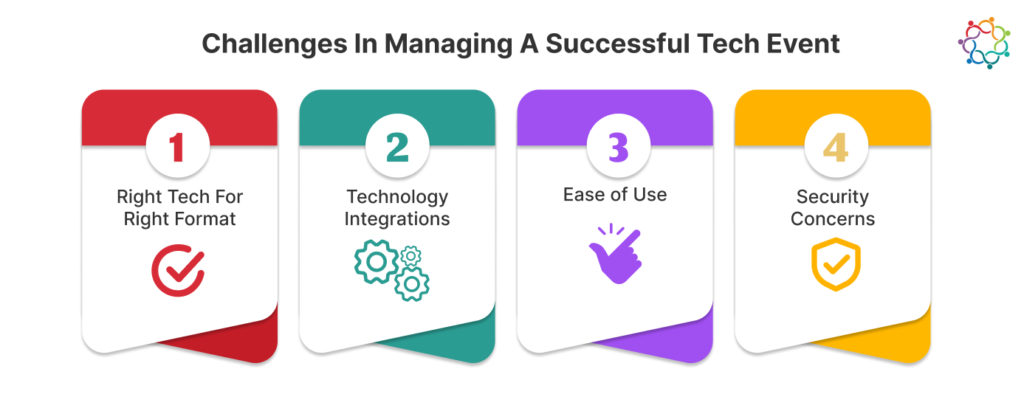
Managing a successful large-scale tech summit is nowhere close to easy, and if you are not using an event management software, it comes with a lot of challenges:
· Right Technology for the Right Format:
Certain events need certain technologies. Without these in place, the event will be in chaos. A tech summit must have tickets, badges, and QR codes along with strong networking facilities and reports. A big conference should have ticketing and registration capabilities. On the other hand, big exhibitions and trade shows need exhibition and sponsorship management functionalities. Having the right technology in place can make or break your event.
· Technology Integration:
Your job doesn’t end with selecting the technologies that you will use. You’ll need to combine them with the knowledge sharing, networking, and entertainment that takes place at events. You might want to provide live chats where attendees can share their opinions with one another and payment gateways that let them make purchases conveniently.
· Ease of Use:
Not all B2B conference organizers have a strong technical background. Implementing and using complex event management software can be challenging, and finding staff with the necessary expertise can be costly.
· Security Concerns:
Data security is paramount, especially when handling sensitive attendee information. Organizers need to choose tech solutions with robust security features and ensure they comply with data privacy regulations.
It is possible to provide your guests with a smoother event experience and save costs at the same time. What you need is a streamlined solution that automates your tasks. Ideally, a single platform that takes all aspects of event management off your hands.
Samaaro has the perfect all-in-one event management software for organizing big tech summits. You can effortlessly create your event websites, streamline ticket booking, and get valuable data insights. Read on to learn more about what the software has to offer:
· Effortless Website Building:
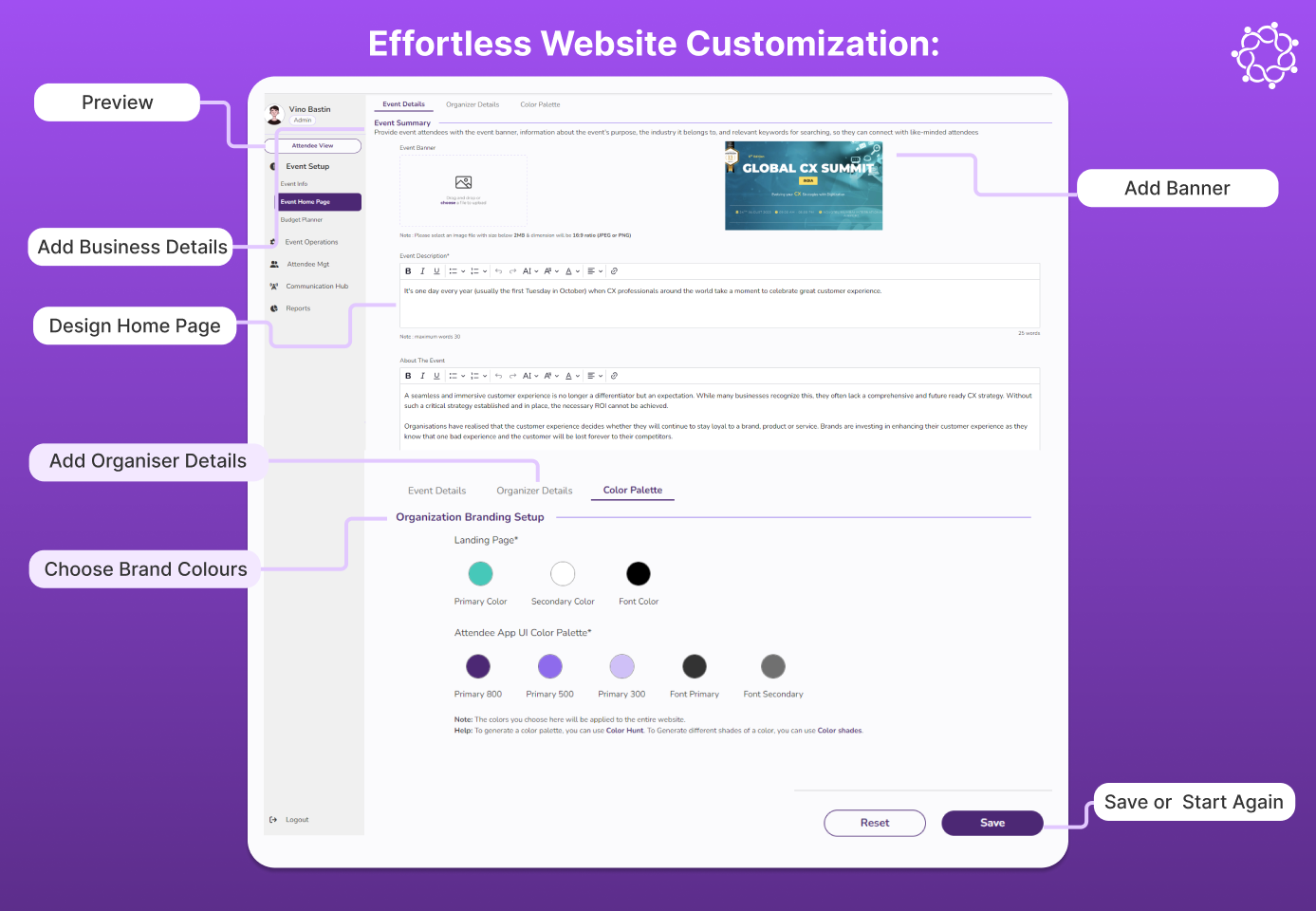
Your website will be fantastic if you can showcase your event’s details, schedule, location, and gallery. Even more so if you can use other features like social media integration, and a seamless transition to payment gateways.
Samaaro’s dedicated event website builder has everything you need to build a completely personalized website! It has multiple customizable features that make content creation and branding simpler. You can select from a wide range of pre-built templates, color schemes, branding elements, and SEO tools. This way, you can reach a newer audience and meet your event’s diverse requirements.
· Streamlined Registration & Ticketing:
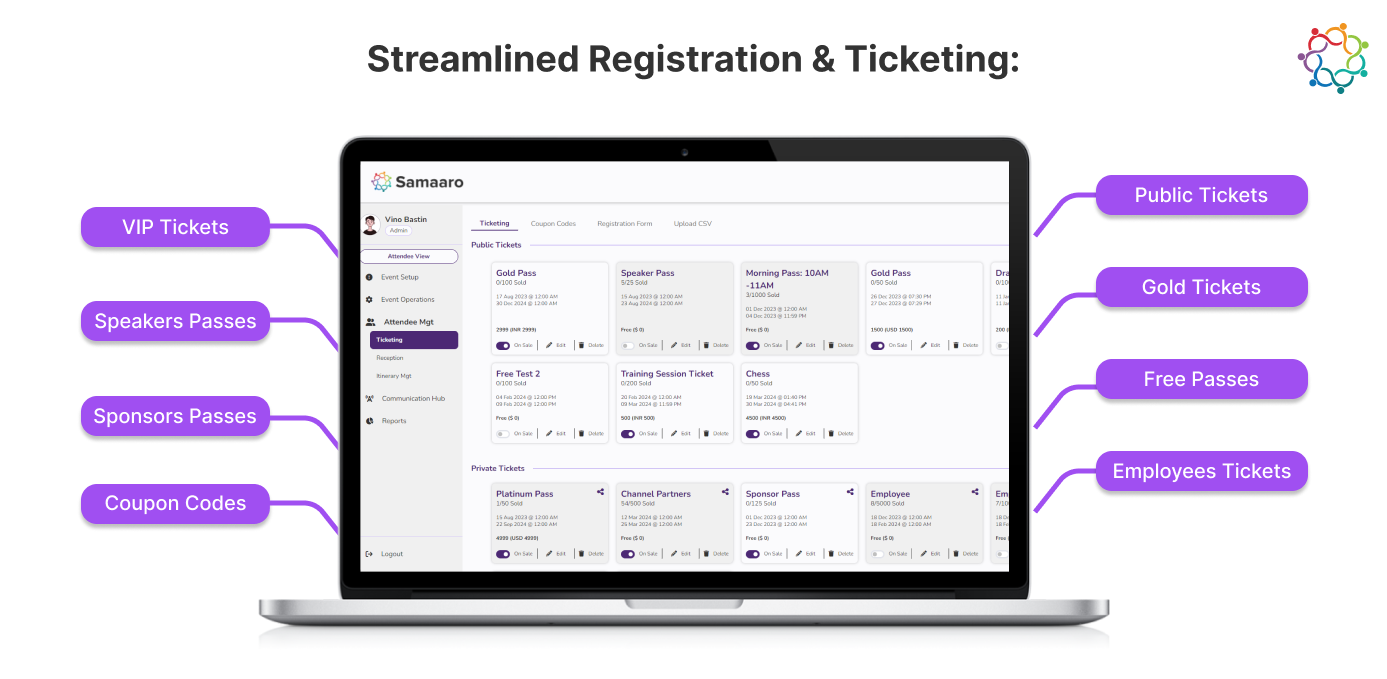
When you conduct large-scale events, it’s important to keep the guests moving. They don’t want to be stopped multiple times and asked to register, produce their ticket, or confirm their seating and VIP access when all they really want to do is get on with what they came there for.
Samaaro’s event registration software is your all-in-one toolbox! It handles both free and paid events, with different ticket tiers like Standard, VIP, and Platinum, each offering exciting perks. You can create special registrations for VIPs and speakers, customize forms, even set up discount codes, all from one central hub. This way, you can manage any event type with ease, leaving you free to focus on what matters most – creating a fantastic experience for your attendees.
· RSVP Management Made Easy:
We understand planning a large event can be stressful! Uncertain guest numbers can make budgeting for things like catering and parking a guessing game. You might also want to personalize the experience by offering goodies or food options based on preferences.
Samaaro helps you gather this information smoothly. Our system lets you create a custom RSVP form with questions about attendance, parking needs, shirt sizes, and even dietary restrictions – all the fun stuff that makes your event special! You’ll have a clear picture of confirmed guests, those who haven’t RSVP’d yet, and the total expected attendance. Plus, Samaaro automatically sends out confirmations and reminders to keep everyone on the same page. Less stress, more fun – that’s the Samaaro way!
· Seamless Check-in & Badge Printing:
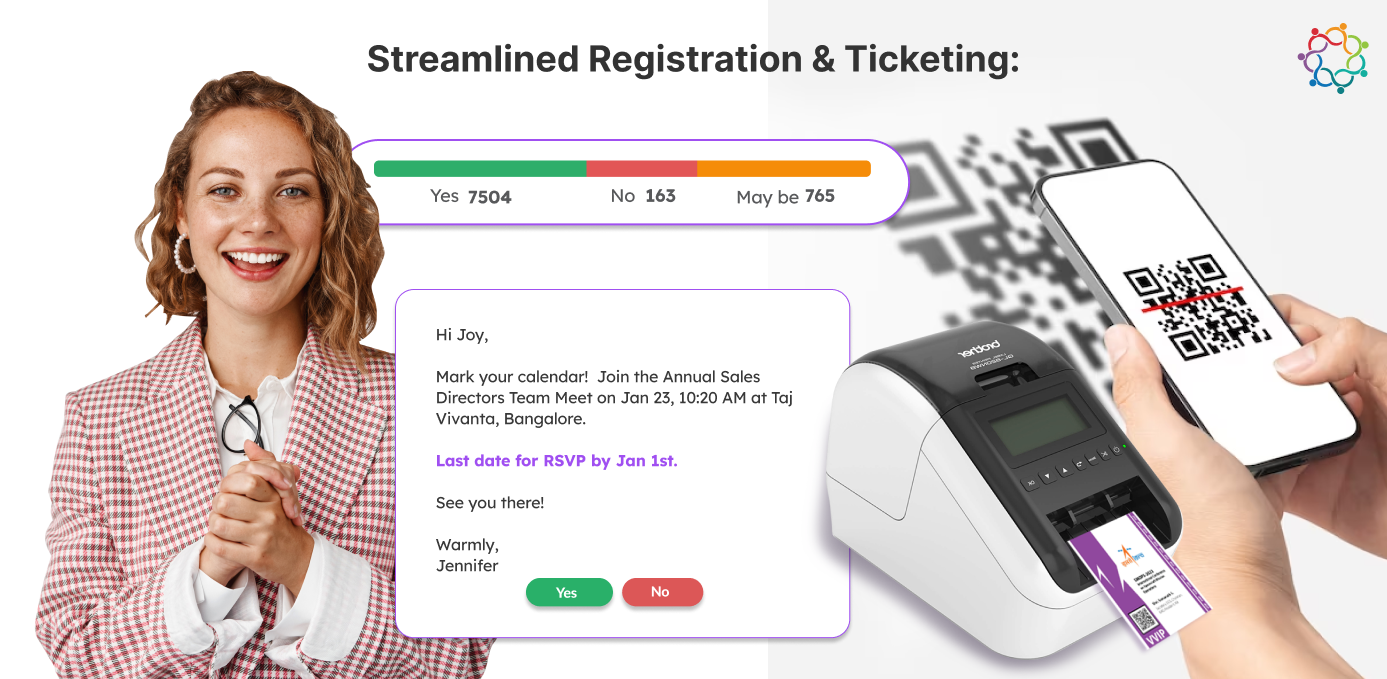
Long winding lines at the entrance do not paint a pretty picture when it’s not for food. Nor are they a good way for guests to check-in or collect their badges. So, you could either assign your staff to the check-in counters, print badges manually, and increase the length of the queues. Or you could send a QR code to each guest, let them scan it before entry, and speed up the entire process of printing badges. The choice is yours.
Samaaro streamlines check-in with personalized QR codes that attendees can conveniently access through email or WhatsApp. No more waiting or last-minute badge printing. You can even create custom badges for different access levels, adding an extra layer of organization. To make the check-in experience even smoother, Samaaro provides an event registration software that lets the speakers avoid the crowds and ensures they feel valued. With Samaaro, a seamless entry process and happy attendees are just a scan away!
· Engaging Attendee App:
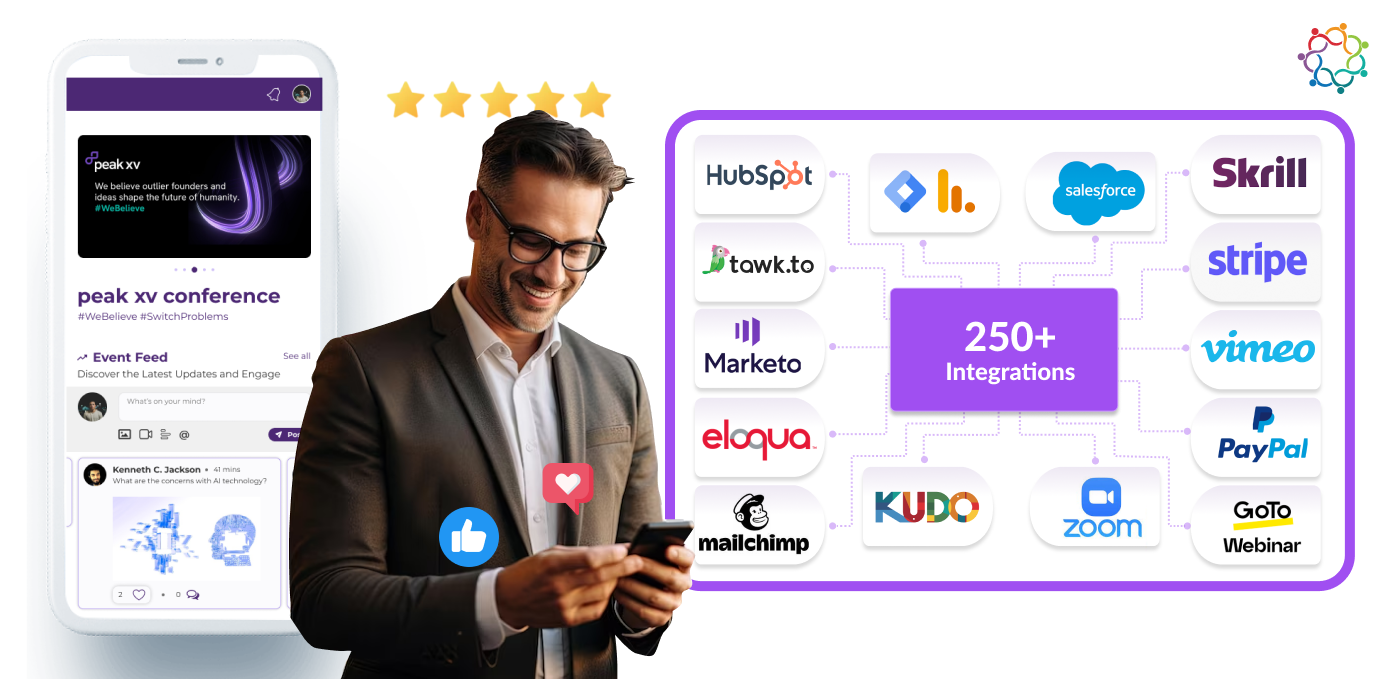
How do you point out the most engaged attendees? They are the ones that use interactive features like live polls, real-time updates, and venue navigation. You won’t believe how engaging a mobile app can be. It lets your guests access the entire event schedule on their mobile and network with other attendees.
Samaaro’s customizable attendee app is a notch better. With it, you can enable your guests to network using messaging tools, interact in Q&A sessions and polls, and receive important information through notifications.
· Event Marketing & Communications:
It’s when you nurture something from infancy to maturity that you get the best results. The same applies to your potential attendees. You need to draw them into the funnel and make sure they improve your conversion rate.
Samaaro has dedicated speaker and sponsor management functionalities that let you run marketing campaigns to promote high-profile speakers. You can also collaborate with sponsors to conduct activities that encourage attendees to stay engaged during the event. Continuous improvement is key to a successful event, so you can use the event management software to send surveys and collect feedback from the attendees.
· Powerful Integrations:
Big tech summits require event organizers juggling a lot of tools. Wouldn’t it be great if everything worked together seamlessly, and you just had to oversee one platform that does it all for you?
Samaaro integrates seamlessly with your existing favorites, like CRMs, email marketing platforms, and survey tools. This means no more jumping between different systems and spending hours on data entry. Samaaro centralizes everything in one place, so you can manage
registrations, send targeted email blasts, and gather feedback – all without the hassle! Focus on creating an amazing event experience and let Samaaro take care of the busywork.
Conclusion
Change is the only constant, so if there is a way to improve your future events, it’s best to follow it. Reinforce your brand identity throughout the summit with Samaaro’s event management software and your guests are going to remember your event long after it is over. Start your free trial immediately and get organizing amazing events.
Ever feel overwhelmed coordinating a fantastic conference? It’s no secret that planning successful events takes a village (or at least a great team and some smart tools!). That’s where Samaaro comes in, your friendly event tech companion! At Samaaro, we understand the diverse demands of event management. That’s why Samaaro’s event management software is designed to simplify and streamline your entire process.
Let’s dive into how Samaaro’s event management software can transform your event planning approach, making it smoother and more enjoyable for everyone involved.
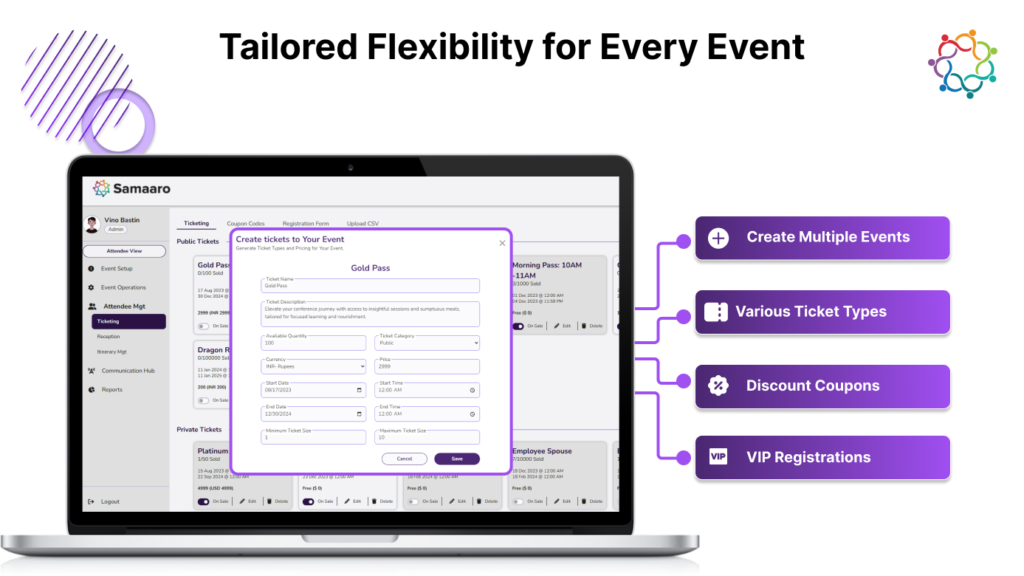
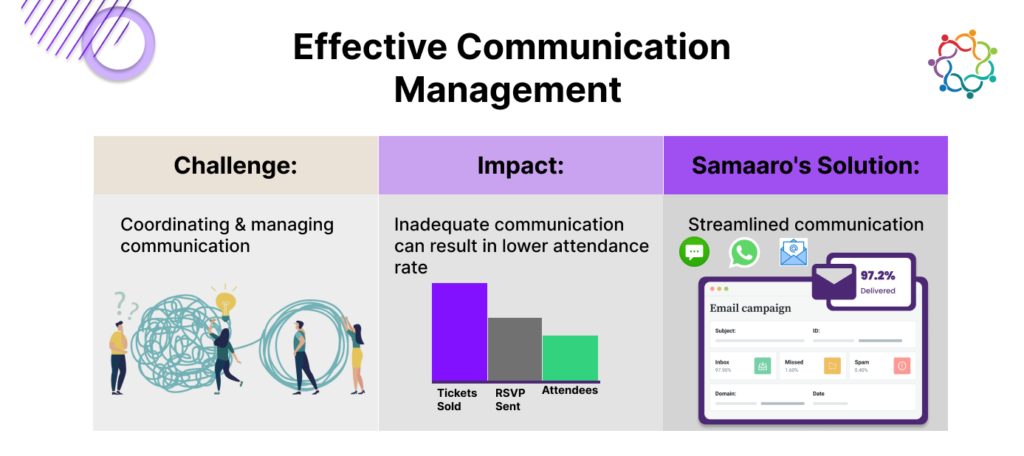
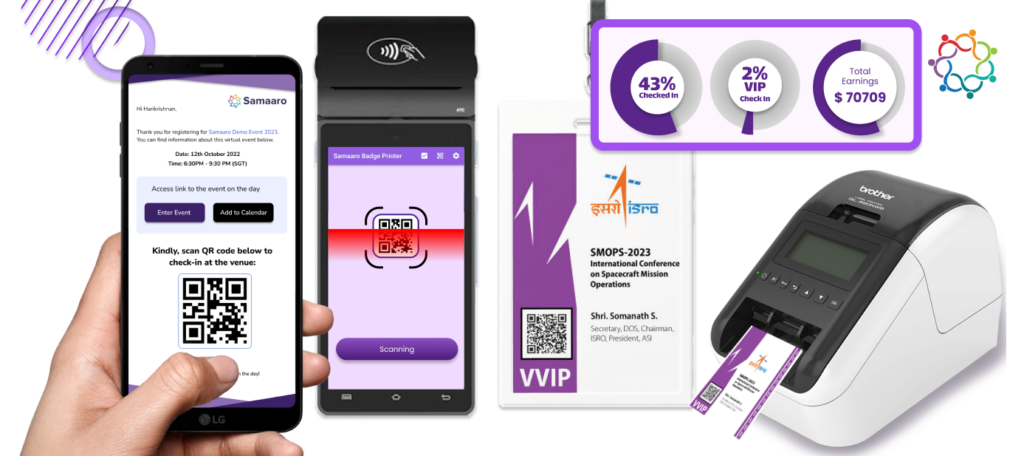
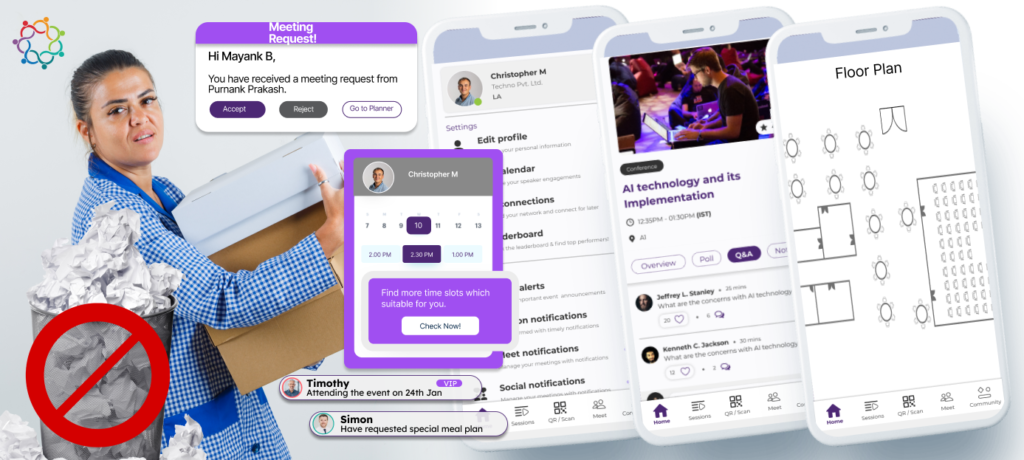
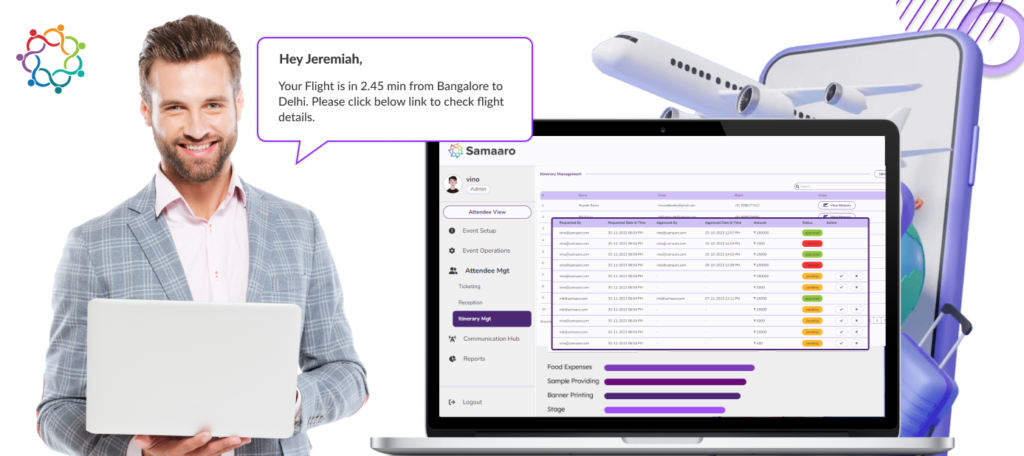
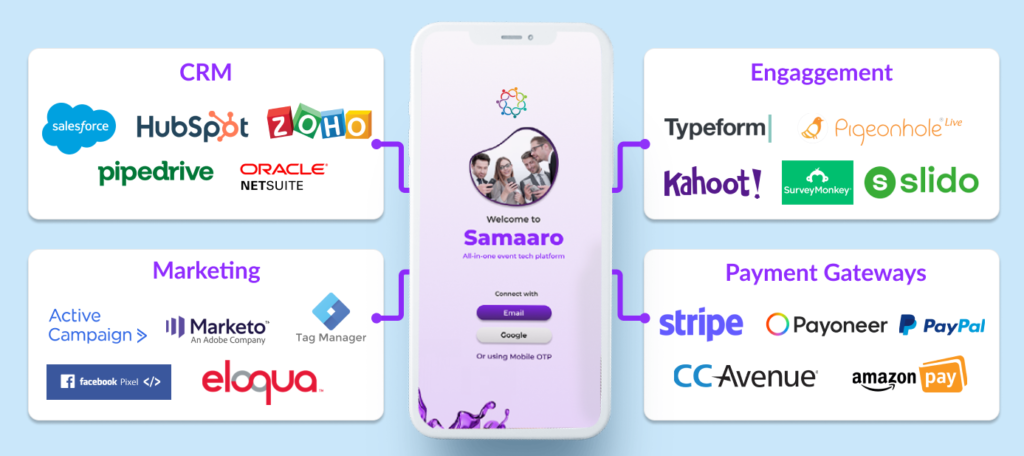
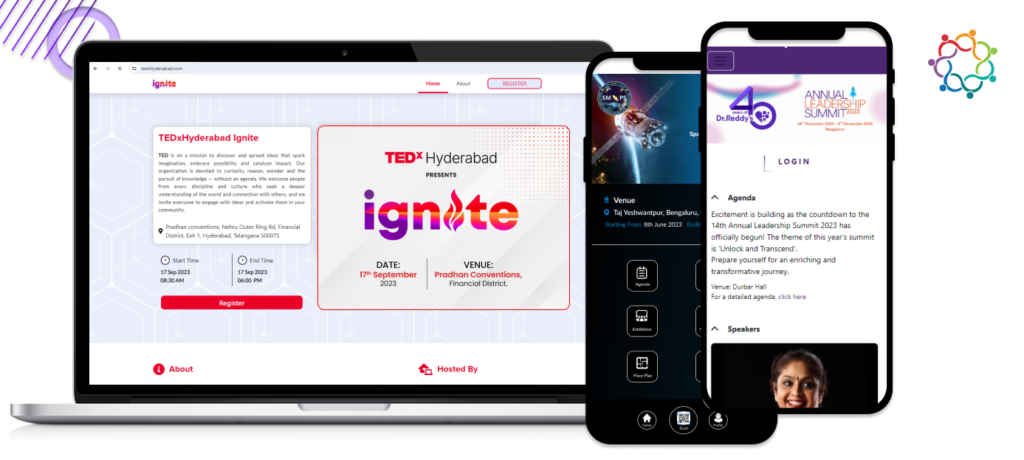
Samaaro understands the challenges event organizers face, and we’re here to help! We’ve seen how our platform can help reduce event overheads by about 15% and operational costs by 5-10% by automating tasks and eliminating manual work. This frees you up to focus on what matters most – creating a fantastic event!
We’re also proud to be trusted by many well-known event management companies around the world. It means a lot to us that they choose Samaaro to help them run their events smoothly and efficiently.
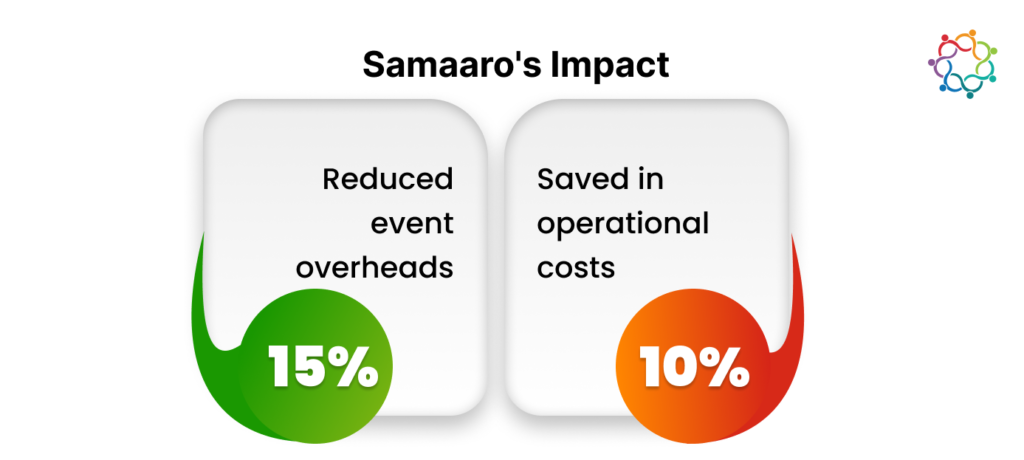

We know event planning can be tough – you need to be flexible, efficient, and make it personal for attendees. That’s where Samaaro comes in! We’re a friendly event management solution designed to help you overcome those challenges with innovative features.
With Samaaro, you can create seamless and unforgettable experiences for your attendees. Think of us as your partner in crime for planning amazing events! Ready to level up your event game? Start your free trial today!
While budgeting is the essential element of event planning, it also involves a host of complicated tasks. As in any mock-up for a community fair, corporate summit, charity ball, etc. Budget planning and management is integral to a successful event and seamless delivery.
The Level of Importance Associated with a Well Managed Budget for Events
Regardless of purpose or size, every event involves some level of financial literacy. A well planned and managed budget provides a financial plan to the organizer, so they understand their options with all of the decisions and spending. A budget is not just a financial reconciliation plan; it is a plan of action that allows a group to; make informed decisions, allocate funds, and reduce or mitigate financial risk.
The Consequences of Successful Events
The consequences of positive acts of budget management have implications for every aspect of an event; quality to services provided; quality of attendee’s experience; attractiveness to potential sponsors; ultimately the defining success or failure of the event.
Strong budgets not only allow the event planner to make decisions within financial limits but also allow planning to use resources in a more productive way, receive better deals/income, increase joint partnerships, and allow for great events experiences with a simple and manageable financial envelope.
Event budget fundamentals
The Importance of Developing a Good Budget Plan
A good budget plan is the foundation of managing an event budget properly. Generally, the budget creation process involves breaking down expenses into categories, estimating costs and then providing a contingency.
Breaking Down Categories
This is important to ensure you stay organized. The common event categories include venue, marketing/promotion, catering, staff, rental equipment, permit/license, decoration and miscellaneous. You will want to categorize your budget by size of the category in total and by estimated cost.
Estimate Costs
Do your research and get quotations and estimates from several vendors in each budget category. To gather competitive pricing you may use costs from previous events as a reference, conduct market research to find what vendors list as cost and also reach out to several vendors and follow through with the most competitive price from several vendors. In your budget indicate the specific cost of each item and nothing left out, regardless of if particular items seem trivial, as this often leads to going over budget.
Contingency
You should generally budget for a contingency between 5 -10 % or more, of your total event budget. The contingency will be an emergency fund, and will cover anything that comes up unexpectedly, or issues arise in the planning and execution of the event.
Negotiation Techniques and Cost-Saving
Properly deploying the negotiation techniques and cost-saving initiatives can make a huge impact on the event budget but not impact the quality of the event.
The negotiating variable into negotiating with suppliers
To get the most hopefully improve your negotiating position with suppliers and vendors improve / expand your negotiating skills.Look for the best price, get package deals, check for additional discounts, or simply negotiate for some extras that fit into your budget. Once you develop a good rapport with your suppliers, they can generally find ways to drop their prices or give you more for your money.
Cost-saving ideas
When looking for cost-saving ideas, try and look as broadly as you can, as you do not want to risk losing the credibility of the event. Some examples of cost-saving promotion ideas can be opportunity costs when looking at locations, catering, or advertising through forms of digital media. Remain open minded and begin thinking about new avenues of creativity that can still get achieve your aims for the event.
Sponsorships and Partnerships
Consider sponsorships and partnerships to offset cost. Encourage partnerships with other companies or organizations that may have similar motivations or reasons for planning the event. Consider providing sponsors some valuable visibility or benefit for their monetary or in-kind support for the event.
Monitoring and Tracking Expenses
Monitoring and tracking expenses helps to ensure that the event budget remains on track so that potential changes can occur.
Utilizing budgeting software
Using budgeting software or budgeting tools with the ability to monitor and track expenses for an event. These tools, can do things like, create reports, automate work-flows, and provide real-time feedback on spending trends.Utilize documents that match the dimensions and dimensions of the event, and hopefully are easy to use for the staff implementing the event.
Frequent Review
Once you have set your budget, you should be regularly reviewing and altering based on your spending. By tracking your spending against your forecasted budget, you will see where you are over your budget or where you have the opportunity for some alterations.
You should also be holding team meetings regularly to ensure everybody is clear on the funding objectives, and to discuss any budget amendments.
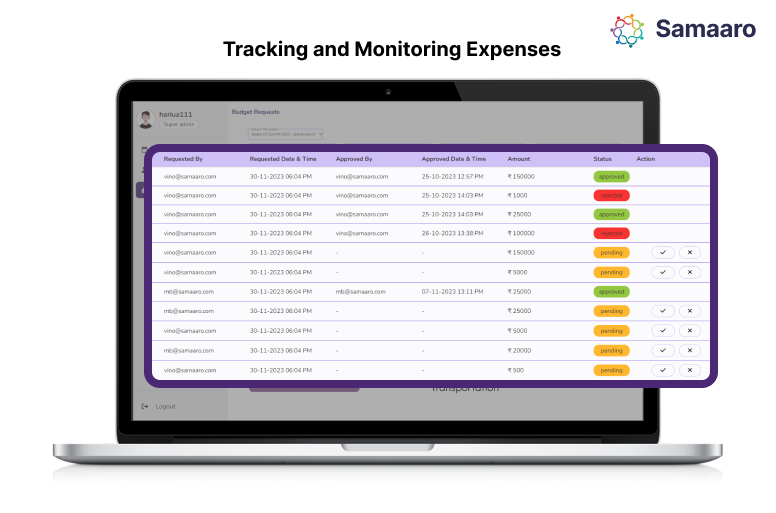
Planning for Contingencies
Planning for contingencies means that you have made plans for when you incur unplanned costs without hindering the success of the event!
Thinking Ahead on Unforeseen Circumstances
You should be thinking ahead to anticipate challenges or emergencies and build a cushion in your budget for costs incurred because of challenges or emergencies.
Ideally, you would be aware of changes in the field and outside influences that can change the financial framework of the event.
Last Minute Changes
Last minute changes or additions are standard practice, and budgeting for them can decrease your stress for finances.
Maintain a smooth line of communication with your vendors or your team, so when changes, are requested by only one person, you will be able to shift on a moment’s notice.
Back-Up Plans
Create a back-up plan to protect key aspects of your event when you face budget cost overruns or other unforeseen occurrences. Back-up plans may include alternate engagement or venders, or, if possible, shrinking the scale of certain aspects.
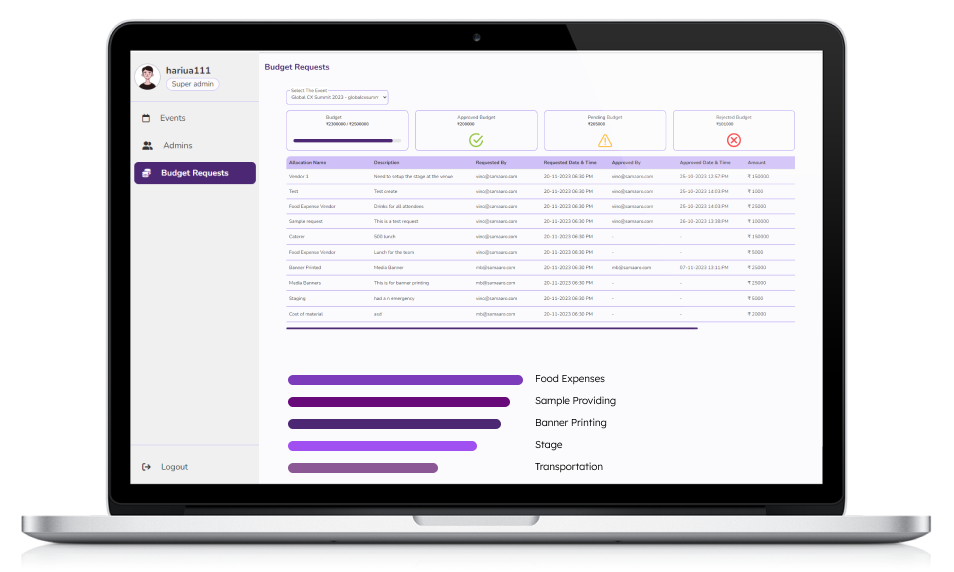
Post-Event Evaluation and Analysis
After the event is complete, an evaluation is useful in keeping pertinent information for future budget use and improvement.
Evaluation of Achievements and Limitations
Compare your planned budget versus your actual budget. Identify to what degree the budget was executed well and when the budget did incur unplanned costs and when it could not meet expenditure.
Also, you can assess success of your event in terms of ROI, level of satisfaction of participants and achieving organizational goals.
Utilize the assessment to achieve successful methods to save money and outline where improvements can be made for future events. Document what you learn from the assessment and alter or modify the budgeting process accordingly.
Conclusion
In closing, one of the dynamic and critical components of the event planning process is financial management of an effective event. An event planner can effectively manage not only financial performance but all aspects of an event on their performance and impact through effectively budgeting, employing cost-cutting and negotiation tactics, monitoring expenditure, preparing for contingencies, and assessing post -event. By adhering to these principles event planners can manage tighter budgets while still executing exceptional events.
Bottom line is that the success of managing budgets is not just about the numbers; it is about planning and being flexible to contingencies when creating whatever is memorable and impactful event that they want to achieve within their budget.
Events are, by nature, networking opportunities, learning opportunities, and authentic, bonding experiences. With so many distractions around us, it’s sometimes difficult to get your audience to be engaged in meaningful ways. The best way to ensure engagement with your audience during an event is to have engagement strategies employed in all three areas: Pre-event, Event, and Post-event. This guide contains simple engagement strategies for each component of an event, so we can help to create meaningful experiences for attendees.
Pre-event engagement
Use Social Media
Social media is a great way to create interest and excitement about an event and keep that same energy when leading up to the event. However, there are ways to not only have audience members engage through social media while they are engaged at the event but want to encourage them to engage after also through follower sharing and likes of their product. For example, you can use methods that would include audience engagement from home through polls about the event, user-generated content supporting the event, and to encourage audience members using the event hashtags corresponding with your event. Not only is this building your community ahead of time, but this also has your audience engaged weeks before the event occurs!
Think of teaser campaigns and countdown
If you are working with presenters of the event, or using event partners, go a step further and collaborate by posting teaser campaigns. You could post a short video of presenters discussing their presentation or partner talking about an amazing vendor item. For early bird registrants, make them feel exclusive and valuable with special packed digital products or discounted access to vendor products.
Offer Interactive webinars and Q&A
Before the event, offer more interactive and engaging webinars or panel discussions with key presenters or other familiar professionals. Ask attendees to submit their questions or topics prior to the discussion to allow for their involvement in the posting process. Announce the events through different branded channels and consider providing the webinars through your website for people who could not make the live events.
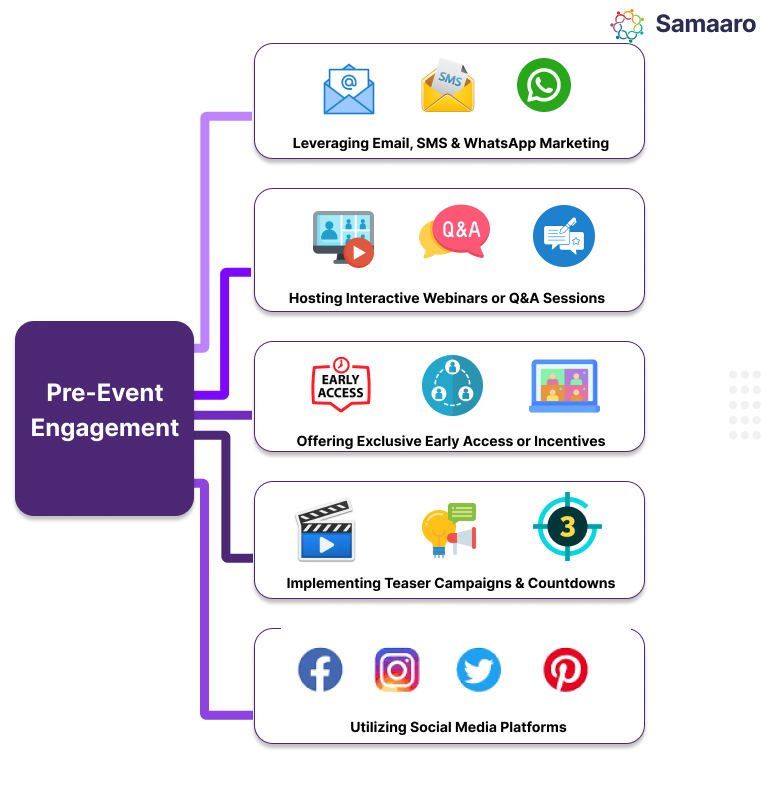
Using Email, SMS & WhatsApp Marketing
For email marketing you can promote event(s) notices, but with email marketing you can send out substantive content like speakers and biographies, session agendas, and sneak peeks of the venue site when you send out email promotions. Email promotions can include RSVPs, interactive maps or customized agenda to attract attendee participation.
During the Event Engagement
Interactive Sessions or Workshops
To promote attendee engagement, plan different session delivery methods, such as conducting an interactive demonstration, round table discussions, or hands-on workshops. No matter which session you schedule ensure you give participants opportunities to share, offer opinions or share for some hands-on experience to create an inviting learning atmosphere.
Encourage Attendee Engagement
Utilize real time interactive tools during your presentations such as live polling, open Q & A coaching sessions and live forums – live action! Give opportunities for the attendees to provide their opinions, questions, or share their experiences with the presenters, and provide interactivity.
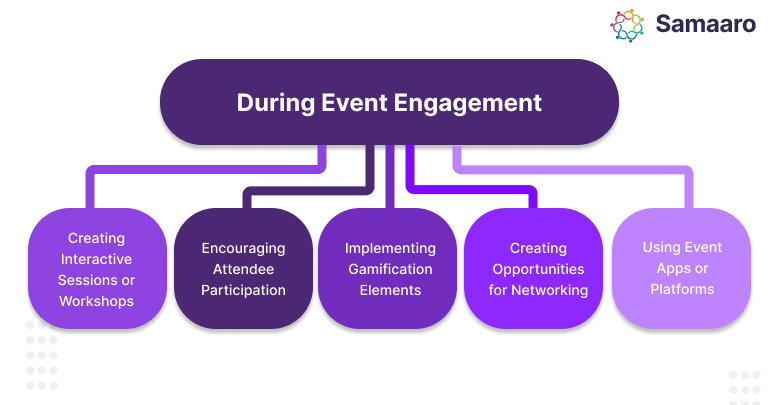
Using Gamification Features
Consider different gamification features such as leaderboards, scavenger hunts, and interactive challenges associated with session engagement. Motivate attendees to engagement throughout the event by offering points for participating in activities that they can redeem for lifestyle benefits or prizes when they return home.
Providing Networking Opportunities
Provide networking opportunities that relate to the attendees’ interests or industry. Consider using an event app to implement matchmaking algorithms for meaningful connections and/or facilitate networking opportunities that promote meaningful connections.
Event Apps or Platforms
Use apps or platforms that are specific to your event to allow your participants to build their unique agenda, chat and share their ideas and opinions live. In addition to agenda building and a chat function, you may want to consider offering engaging experiences through interactive maps, live polling, or a rating of sessions.
Post-Event Engagement
Personalized Thank You Emails
Create email follow-ups to the event to both say thank you and highlight any personalized positive things that were relevant to that participant’s interests. To enhance the value of the post-event follow-up, add in appropriate hyperlinks to any resources or recordings, or follow-up information that was shared at the event.
Share the Event Story
Create a comprehensive content strategy for post-event. Share behind the scenes, event highlights, snippets of keynotes, participant testimonials and sneak previews through newsletter and social. Be sure to create content in engaging formats, such as blog recaps, videos or infographics to maximize engagement and reach.
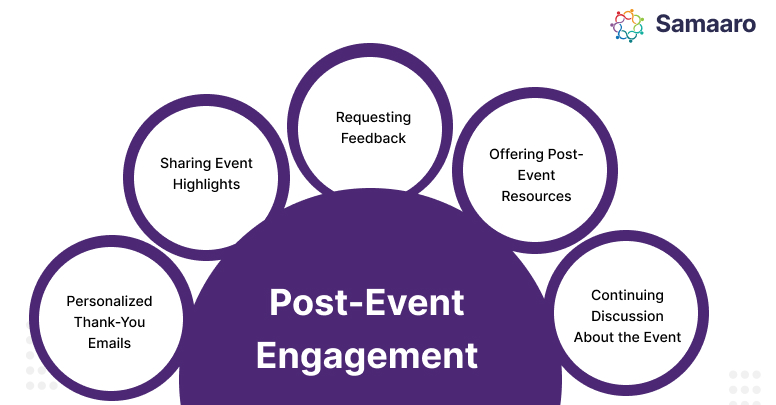
Feedback Collection
Create a detailed survey or questionnaire for participants to reveal feedback in greater depth about a variety of aspects of your event, including programming, networking opportunities, operations, and participant satisfaction. Even the best feedback will never capture the event nor the significance of the event in a meaningful way, so consider feedback to emphasize what will be an improvement opportunity for the next event.
Post-Event Resources
Allow participants to be able to access recordings, slides, whitepapers, and whatever other resources were shared during the event at their convenience. Give participants a central location and repository of resources that they can access and use to further their education beyond their event.
Post-Event Social Engagement
Once the event has ended, begin the conversation on social media and/or online communities focusing on the event’s content; allow participants to continue networking and discussing their experiences, and key take-aways from the event. Continue to give participants opportunities to engage through materials, discussions, or special offers; continuity of the participants experience is important – they will continue to relate to or reference things they heard or learned at your event.

Personalize experience – personalize experiences based on attendee preferences/interests
Use a variety of mediums – use visually engaging content including videos, infographics, graphic organizers, etc.; and interactive engagement
Follow up – provide meaningful networking introductions or experiences
Communicate – communicate with participants in the lead-up to, during and, following the event in order to keep them engaged
Measure success/ data – Look at data to understand what was successful, and to look for anything else that needs improving.
Successful in-person events don’t just happen; they are planned experiences that involve attendees. By employing pre-event, during-event, and post-event engagement, we, as event managers, can create memorable experiences that matter to attendees.
Finally, event engagement is a journey, an evolutionary process that involves innovation, personalization, and knowing what the attendees’ needs and interests are. When using these different engagement strategies along with Samaaro, we can enhance attendee experience and increase the experience of what can be an extraordinary in-person event. Give Samaaro a try! Sign up today for a free trial!
Events provide businesses with dynamic platforms to interact with their audience, cultivate relationships, and increase brand awareness. However, in addition to its execution, the success of an event is also determined by the Return on Investment (ROI) it produces. Event ROI represents the effectiveness of an endeavor in attaining predetermined goals in comparison to the resources that were allocated. This blog examines the critical nature of event return on investment (ROI) measurement with the help of Samaaro and investigates the fundamental metrics required for a thorough assessment of this achievement.
To support their event expenditure and be able to effectively assess impact on the bottom line, organizations must evaluate event ROI. ROI is an organizational tool that stakeholders can use to effectively manage resource allocation, facilitate tactical strategies, and make operational decisions based on data. Organizations glean knowledge about the event’s strengths and weaknesses through the measurement of ROI, which contributes to their ongoing growth and success.
To understand Event ROI, an all-encompassing exercise which addresses several key performance indicators, will be required to constitute a complete measurement of the event’s success. These measures encompass attendance, engagement, social media impact, lead generation, customer satisfaction, post-event conversion and much more. As organizations measure the event across multiple measures, they will more fully understand the overall event effectiveness and practical learnings about how they can be better next time.
Defined and precise objectives establish the foundation for an event that achieves success. The range of objectives may be extensive, including but not limited to expanding brand recognition, introducing a novel product, cultivating connections within the industry, or stimulating sales. Having clear objectives facilitates the delineation of strategies, the selection of suitable metrics, and the accurate evaluation of the event’s success.
Different types of events serve different purposes; therefore, the purpose can differ. For example, a trade show might prioritize networking and creating leads, while a thought leadership symposium might want to establish thought leadership and authority in an industry. Events can be categorized based on attributes and purposes; organizations are then able to align exact metrics that are tailored to measure success in an efficient way.
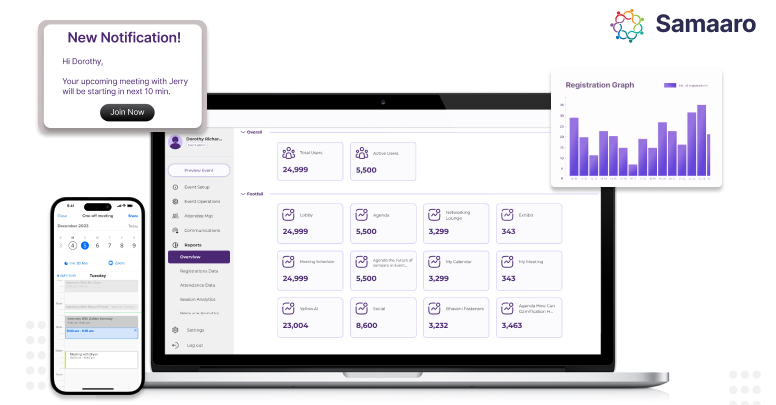
Ticket Sales and Attendance
Attendance figures and ticket sales are essential performance indicators that gauge the preliminary triumph of an event. By utilizing these metrics, one can quantitatively evaluate the extent and level of appeal of an event. Understanding attendance figures, however, necessitates a more nuanced examination than mere numerical data. By dividing attendee data into segments according to demographics, geographical locations, or registration sources, significant insights can be obtained regarding audience preferences and the efficacy of marketing approaches.
Examining ticket purchase patterns- including evaluating the influence of price levels or discounts, may provide insight into the effectiveness of your price strategy and if they have changed the overall revenue stream from the event. Furthermore, real-time knowledge of attendance patterns during the event (high attendance, first session versus second, etc.) will improve the planning and scheduling of future events.
Online vs. On-Spot Registration Ratio: Measure the proportion of attendees registering online versus those registering on-site.
Revenue Distribution Across Ticket Tiers: Analyse the sales distribution among different ticket categories to identify revenue streams.
Sales Patterns: Weekday vs. Weekend and Time of Day: Assess ticket sales trends based on the day of the week and time slots.
Lead Generation and Conversion Rates
Events provide substantial prospects for the generation of leads. In addition to data collection, lead quality analysis is of utmost importance. A discrepancy exists between leads generated during an event. Prioritizing post-event follow-up efforts can be facilitated by evaluating lead quality according to criteria such as industry relevance, purchasing intent, and levels of engagement during the event.
The conversion rates taken from prospects that were generated by the event clearly provide information regarding the effect of the event on the sales funnel – or pipeline – of prospects. Understanding the conversion journey from the first engagement that was initiated at the event all the way through to the final sale is vital for organizations to identify opportunities to improve or obstacles to conversion to reach the end goal with subsequent events.
Number of Qualified Leads Collected: Track the total count of potential leads gathered during the event.
Lead Conversion Rate from Event Engagement: Measure the percentage of event-generated leads that convert into customers.
Time from Lead Acquisition to Conversion: Determine the average duration it takes for event-acquired leads to convert into paying customers.
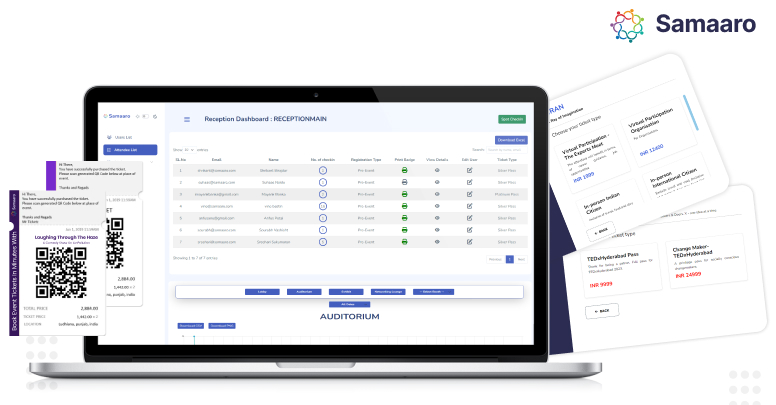
Engagement Metrics (Attendance, Duration, and Interactions of Sessions)
Evaluating attendee engagement metrics throughout an event yields invaluable insights regarding the most impactful content and activities for the attendees. Identifying the most captivating aspects of the event is facilitated by analyzing session popularity according to topics, speakers, or formats, in addition to monitoring session attendance. Moreover, an assessment of session duration or dwell times provides insight into the degree of audience engagement and curiosity regarding the presented material.
By doing interaction monitoring every session or activity, you are gaining an all-encompassing evaluation of how participants are participating through their interactions with polls, questions they presented, or contacts they have made. If you incorporate interactive technology, such as interactive equipment or apps, your ability to evaluate engagement will be magnified and can adjust during the event based on real-time feedback.
Session Attendance Rate: Measure the percentage of registered attendees who participate in specific sessions.
Average Session Duration: Calculate the mean duration attendees spend in event sessions or workshops.
Number of Interactions per Attendee: Track the average count of interactions (questions, comments) made by each attendee.
Social Media Impressions and Reach
It is critical to utilize social media in the digital age to expand the scope of an event. In addition to physical attendance, reach, impressions, shares, and engagement metrics across multiple social platforms serve as indicators of the event’s digital prominence and influence. By monitoring particular hashtags or discussions pertaining to events, organizations can assess audience sentiment and online sentiment in real-time.
Moreover, analysing social media engagement and interaction before, after, and during the event will provide a thorough perspective on the impact of the event on social. This will allow for the identification of successful approaches to social media, identifying important partners or attendees, and the development of future social media campaigns.
Total Reach and Impressions Across Platforms: Monitor the overall visibility and exposure of event-related content on social media.
Engagement Rate (Likes, Shares, Comments): Evaluate the level of audience engagement through likes, shares, and comments on event-related posts.
Sentiment Analysis: Positive vs. Negative Mentions: Analyse the sentiment of social media mentions related to the event.
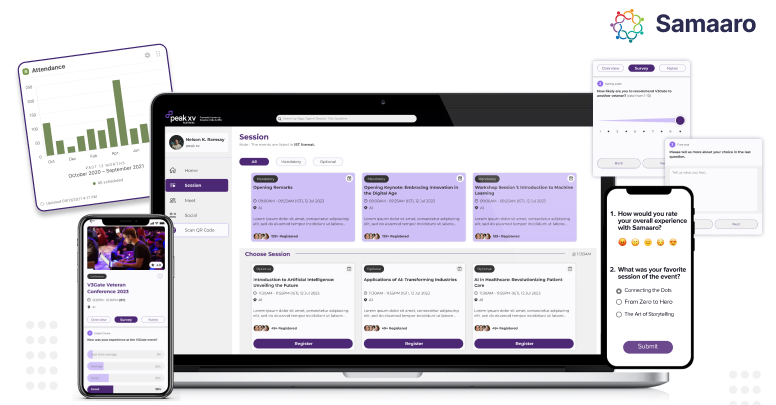
Customer Feedback and Satisfaction
The acquisition of exhaustive feedback from attendees via post-event surveys or evaluations is crucial for determining the level of customer satisfaction as a whole. Quantitative ratings yield a numerical evaluation, whereas qualitative feedback provides a more comprehensive understanding of the experiences, preferences, and areas requiring enhancement of the attendees.
Examining trends in feedback among demographic and participatory groups allows for the recognition of habits and issues that occur. This information helps organizations customize future events to address the varying needs of their participants. Moreover, responding quickly to positive feedback helps develop participant trust and loyalty.
Overall Satisfaction Score from Post-Event Surveys: Assess the general satisfaction level of attendees through post-event surveys.
Net Promoter Score (NPS): Measure the likelihood of attendees recommending the event to others based on a standardized scale.
Feedback on Specific Event Elements (Speakers, Content, Logistics): Collect feedback on specific aspects of the event to pinpoint areas for improvement.
Post-Event Conversions and Sales
It is critical to monitor sales and conversions in the aftermath of an event in order to ascertain its enduring influence on business results. By examining the purchasing behavior of attendants after the event, such as conversions and follow-up interactions, one can establish a link between event attendance and measurable business outcomes.
Revenue Generated Post-Event: Calculate the total sales or revenue directly attributed to the event after its conclusion.
Conversion Rate of Post-Event Leads: Measure the percentage of leads acquired during or from the event that convert into sales.
Upsell or Cross-Sell Opportunities Identified: Identify additional sales or upselling opportunities realized post-event.
Pre-Event Organization Techniques: Adapt event strategies in accordance with objectives. To maximize impact, employ targeted marketing strategies such as audience segmentation and personalized communication. The utilization of attendee data from previous events facilitates the improvement and targeting of strategies.
On-Site Engagement and Interaction: Drive engagement in your educational program through interactive sessions, networking, gamifying games, and immersive experiences. Engagement is heightened through technology and tools, such as virtual reality or event applications. Network and collaborate in innovative ways through networking activities, polls, or live Q&A.
Post-Event Follow-Up and Analysis: Utilize the gathered data and feedback from attendees to conduct an exhaustive analysis. Insights should be utilized to improve future events. Follow up with prospects in a timely manner to convert potential opportunities and capitalize on generated interest. By delivering exclusive post-event content or offers, attendance is further increased.
Beyond merely measuring returns on investment (ROI), event evaluation involves understanding how the event is contributing to the global plans of the organization. When you put the focus on these six key indicators, along with pre-planning and post-evaluation, you can optimize your events to the greatest extent possible and achieve specific, identifiable outcomes. Assessing return on investment (ROI) is more than just assessing the event, it is a continuous process of engaging in a development of strategies to ensure sustained success in future events.
The untapped potential of event data rests at the heart of this data-driven revolution in the hyper-connected world of today. Samaaro, a pioneering Event Management System (EMS), acts as a catalyst, facilitating the realization of event data’s inherent value and indicating in a moment of new possibilities. In this blog, we will delve into the profound significance of event data, the challenges it presents, and the transformative benefits offered by Samaaro.
Event data is an indispensable resource for modern businesses, providing exceptional visibility into user conduct, trends in the market, and operational effectiveness. Event data is used in a variety of sectors, including finance, healthcare, and marketing, to improve consumer experiences and streamline operations.
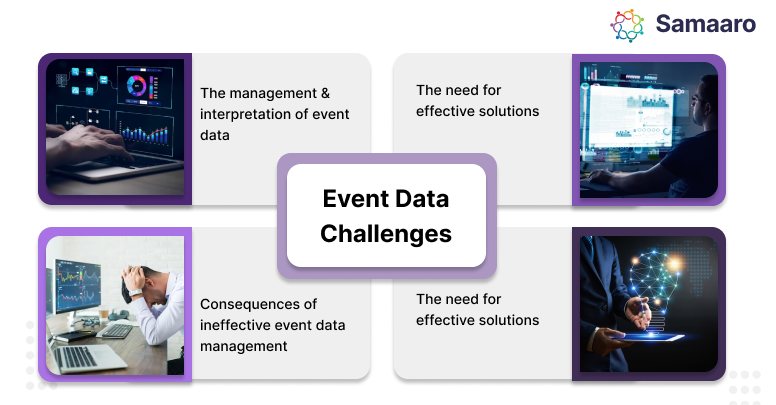
A. The management and interpretation of event data
Efficient administration and interpretation of event data pose significant challenges due to their immense volume and intricate nature. The complexity of extracting meaningful insights is made harder by the unstructured nature of data streams and the requirement for real-time processing.
B. Consequences of ineffective event data management
Mismanagement of event data can result in significant ramifications, including the failure to capitalize on opportunities, prolonged response times, and compromised decision-making processes. Frequently, the potential insights required for fostering growth and innovation remain elusive, resulting in a disconnect between data and strategies that can be effectively implemented.
C. The need for effective solutions
Recognizing the urgent need for solutions that not only manage but also extract significant value from event data, Samaaro steps into the spotlight. Designed to address the intricacies associated with event data, Samaaro serves as a bridge between raw data and actionable intelligence.
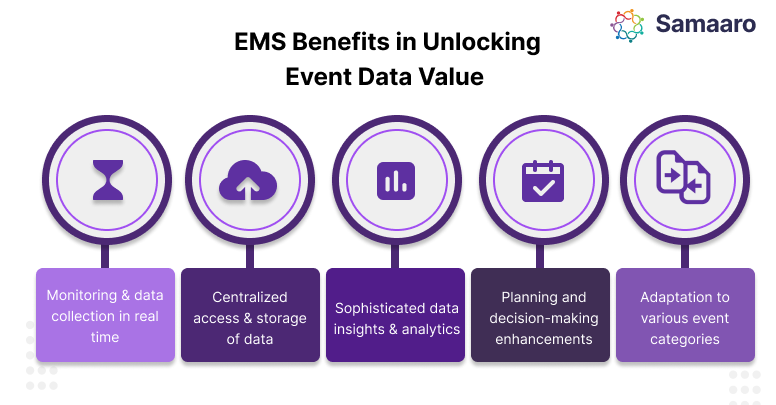
A. Monitoring and data collection in real time
By capturing and processing event data in real-time, Samaaro’s EMS provides organizations with an uninterrupted flow of information. This functionality empowers organizations to maintain a competitive edge by promptly addressing emerging trends and prospective challenges. Moreover, the intuitive interface of the platform guarantees that the data gathered is not only comprehensible but also capable of being implemented.
B. Centralized access and storage of data
The foundation of efficient data management is centralization, and Samaaro effortlessly accomplishes this. A centralized archive stores all pertinent information, thereby simplifying access and obviating the difficulties associated with dispersed data sources. In addition to streamlining data administration, this centralized approach facilitates cross-functional decision-making and improves collaboration.
C. Sophisticated data insights and analytics
Beyond fundamental data storage, Samaaro integrates comprehensive analytics tools that convert unprocessed data into practical insights. By incorporating machine learning algorithms and predictive analytics, Samaaro enables organizations to gain insights into trends, recognize favorable circumstances, and enhance their success-oriented strategies.
D. Planning and decision-making enhancements
Samaaro empowers decision-makers to make well-informed choices by utilizing data-driven insights in real-time. Every decision, encompassing resource allocation and marketing strategies, is supported by an exhaustive comprehension of the event environment. Samaaro guarantees that comprehensive reports and visualizations are provided to decision-makers, thereby enabling them to engage in more efficient planning and implementation.
E. Adaptation to various event categories
Samaaro demonstrates its understanding that not all events are equivalent by providing customizable solutions that are specifically designed for a wide range of event categories. The platform successfully adjusts to the distinct data needs of various types of gatherings, including conferences, webinars, trade shows, and virtual events, thereby guaranteeing the production of pertinent and implementable insights.
For its SMOPS-2023: International Conference on Spacecraft Mission Operations, ISRO faced various challenges and sought an advanced event technology platform to enhance the overall attendee experience. A key concern was effective data tracking, as attendees struggled to make informed decisions due to limited online event information. ISRO aimed to elevate its event monitoring system by leveraging cutting-edge technology for precise data collection and comprehensive parameter monitoring. Samaaro stepped in to address these needs. Recognizing the significance of data security, Samaaro designed a platform where all information was exclusively accessible to moderators. The solution provided real-time access to data and downloadable reports, ensuring a seamless and secure event management experience for ISRO.
Samaaro emerges as a transformative force for organizations seeking to unlock the true potential of event data. As we continue to navigate the complexities of modern business, Samaaro stands as a beacon, illuminating the path towards data-driven success. In a world where data reigns supreme, Samaaro empowers organizations to not only collect and manage data but to extract actionable insights that propel them towards unparalleled success. Don’t wait! Start your free trial now!
Events provide an opportunity for people to engage in networking, exchange knowledge, and forge everlasting memories. However, one key aspect determines the outcome of any event: efficient event registration and ticketing. Although it may appear to be an inconsequential aspect, it has the potential to significantly impact the success or failure of your event.
The registration and ticketing process is the initial point of contact for attendees at your event. A seamless and user-friendly system can leave a positive mark, while a complicated and tedious process can deter potential attendees. Additionally, effective ticketing has a significant impact on the revenue and management of your event.
A suite of features provided by Samaaro are intended to streamline the complete process, from beginning to end. Samaaro can accommodate your specific event needs, whether you are organizing a small workshop or a large-scale conference.
This blog will provide an in-depth analysis of Samaaro, including an examination of its features, customization capabilities, past success, and the numerous advantages it presents to organizers. By the time you’re through reading, you’ll understand why Samaaro is the ultimate choice for anyone looking to elevate their event registration and ticketing game.
Samaaro boasts a robust set of features that make event registration and ticketing a breeze:
Landing Page
First impressions matter. With Samaaro, you can create a stunning event landing page that captures your event’s essence. By personalizing the landing page to align with the event’s branding and theme, one can establish an online presence that is both aesthetically pleasing and unified.
The landing page can include significant event information, including but not limited to the date, venue, timetable, speaker biographies, sponsors, and hyperlinks to supplementary resources such as downloadable materials or pertinent websites. You facilitate attendees’ enthusiasm for your event and enable them to locate the information they seek without difficulty by arranging and aesthetically presenting this data.
Customized ticketing options
Samaaro’s customized ticketing options provide event organizers with the flexibility to tailor their ticketing strategy to the specific needs of their event. Depending on your event type and audience, you can create a variety of ticket categories, pricing tiers, and packages to attract a diverse range of attendees.
This customization ensures that your event is accessible and appealing to a broader audience, increasing the chances of achieving higher ticket sales. By accommodating different preferences and budgets, you can maximize your event’s potential for success.
Payment options
Samaaro provides support for a range of payment gateways, enabling participants to conveniently and effortlessly complete the registration process by utilizing their preferred method of payment, be it PayPal, credit cards, or other viable options. Consequently, this increases the revenue and ticket sales for your event.
Moreover, accommodating a multitude of currencies and payment gateways, Samaaro’s comprehensive payment system is appropriate for both domestic and international gatherings. With the support for multiple currencies and a variety of payment methods, your event will be able to effortlessly process payments from around the world and appeal to a global audience.
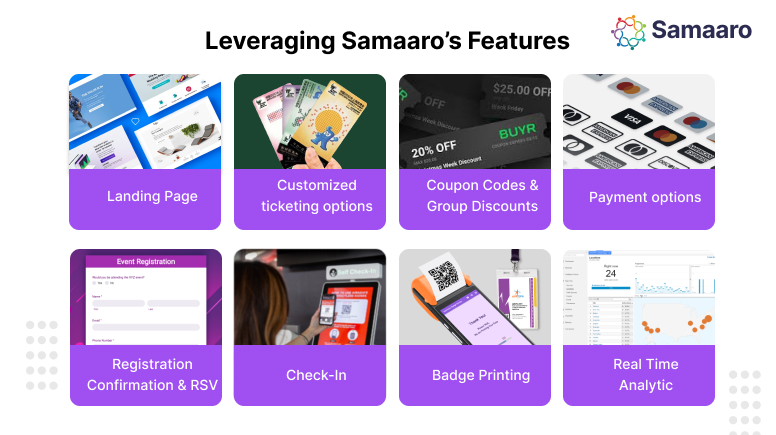
Registration Confirmation & RSVP
Upon registration, participants receive confirmation notifications through multiple channels, including email, SMS, and WhatsApp, offering flexibility and convenience for attendees. Additionally, event organizers have the option to streamline the process further by uploading a list of anticipated attendees and prompting them to RSVP in advance. This feature simplifies logistics and helps organizers better prepare for the event.
Check-In
Efficient check-in processes are essential for the smooth operation of any event. Samaaro offers a check-in feature that simplifies and streamlines the check-in process for attendees. With Samaaro’s check-in system, attendees can quickly and conveniently check in upon their arrival at your event. The intuitive interface ensures a hassle-free experience, reducing the likelihood of long lines and ensuring that potential attendees become confirmed guests.
Badge Printing
In addition to efficient check-in, Samaaro also offers a badge printing feature that adds a professional touch to your event while further enhancing the check-in process.
When attendees arrive at your event, they can receive personalized identification badges or badges with QR codes, which can be quickly scanned for entry. These badges can be customized to include the attendee’s name, affiliation, and any other relevant information, providing a personalized touch to the event experience. Moreover, Samaaro’s badge printing feature automates the badge creation process, reducing the potential for human error and saving precious time.
Real Time Analytics
Samaaro provides event organizers with the ability to access critical data and insights in real-time through its analytics capabilities. By delivering a consistent flow of data regarding attendee engagement, behavior, and other critical metrics, this functionality empowers event organizers to formulate well-informed decisions based on empirical evidence throughout the course of the event.
Real-time analytics provide numerous advantages, including the capacity to assess session popularity, monitor attendance figures, and detect emerging trends or challenges that may arise throughout the event. Organizers may reallocate resources in response to an unanticipated overcrowding of a specific session, for instance, by relocating to a room of greater capacity or modifying the timetable to replicate the session. On the contrary, in the event that a session fails to attract sufficient attendance, organizers may contemplate consolidating it with another or increasing its promotion.
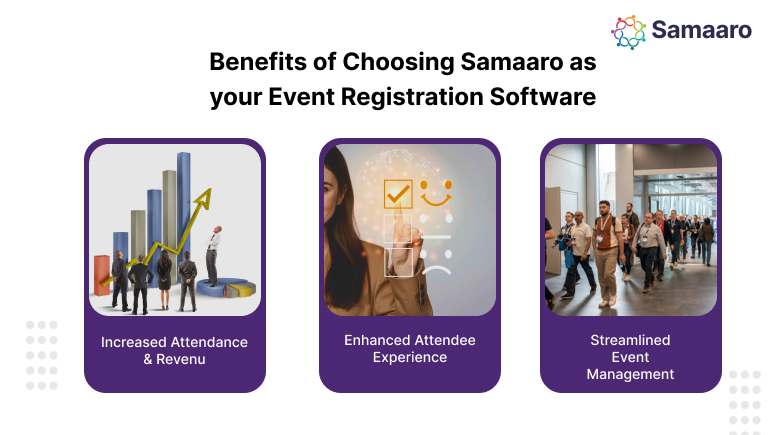
A. Increased Attendance and Revenue
Samaaro is an assured method of increasing revenue and attendance by streamlining the registration process and providing a diverse selection of payment methods and ticket choices. Your event’s financial success is virtually assured with increased attendance and streamlined ticket sales.
B. Enhanced Attendee Experience
Samaaro’s benefits extend beyond the event organizer to the attendees as well. It significantly improves their experience. Your attendees will enjoy themselves and have a favorable perception of your business because of a streamlined registration procedure, badge printing on-site, and real-time information.
C. Streamlined Event Management
Samaaro streamlines the process of event management, which can otherwise be a logistical maze. You can adapt your event in real time and make decisions based on data with the assistance of real-time analytics and personalization. For the event organizers, this results in a more structured and less anxious day.
TEDx Hyderabad
TEDxHyderabad encountered considerable difficulties in controlling the number of attendees and paying excessive payment gateway costs. They were unable to evaluate marketing activities because there was no efficient way to track coupon-based registrations. Samaaro cut costs and integrated Indian payment alternatives into a comprehensive ticketing system to address these problems. Group participation and resource allocation were encouraged with flexible discount codes and vouchers. Utilizing email and WhatsApp as part of Samaaro’s event marketing strategy increased registration and participant engagement. Over 1,250 people registered, 136 different types of coupons were used, the check-in process took only 75 minutes, and there were over 40,000 communications. These were outstanding results.
Major Agricultural Exhibition in Brazil
Samaaro came up with a novel way to handle an 80,000-person farming event with a variety of linguistic backgrounds. Language obstacles were removed when individuals could register using customizable forms available in English, Portuguese, and Spanish. Twelve check-in counters were manned by volunteers with tablets and an easy-to-use registration system from Samaaro, which let the registration process run smoothly. Farmers that were knowledgeable could join without any problems. Due to effective technology and planning, 800 farmers were able to register at a time at each kiosk in an average of just 45 seconds. This case study demonstrates how well-thought-out preparation and cutting-edge technology can produce a seamless, welcoming event experience.
Unlimited Events & Unlimited Tickets
With Samaaro’s free ticketing solution, you can host an unlimited number of events, from workshops to concerts, with no restrictions. But that’s not all! You can also sell an unlimited number of paid tickets for your events, giving you complete flexibility to create and manage various ticket types. This feature alone sets Samaaro apart, as many other platforms impose limitations on event and ticket numbers.
Unlimited Tickets and Coupon Codes
Samaaro empowers you with endless possibilities by offering unlimited tickets and coupon codes. Customize your ticketing strategy and run promotions without constraints. Your creativity knows no bounds when you work with Samaaro.
Transparent Pricing
One of the most outstanding features of Samaaro is its transparent pricing structure. With only a 3% platform convenience fee and no hidden charges, you’ll always know what you’re paying for. Unlike other event management companies that surprise you with additional costs, Samaaro ensures you have full clarity on your expenses.
Custom Registration Forms
Your event’s registration process can be a crucial element in creating a positive impression. Samaaro empowers you to design custom registration forms that capture essential attendee information. Tailor forms to gather insights into attendee preferences, demographics, or any data specific to your event’s requirements. This information can be invaluable for planning future events and fine-tuning your marketing strategy.
Personalized Registration Emails
First impressions matter, and personalized registration emails can set the tone for your event. With Samaaro, you can craft and send tailored emails to your attendees, offering a personal touch that conveys your appreciation and commitment to their event experience. A positive and personalized interaction can go a long way in building attendee loyalty.
Samaaro’s adaptability and extensive feature set enable it to meet the specific needs of various types of events. It is not a one-size-fits-all solution; instead, it can be tailored to address the unique requirements of your event. From increased attendance and revenue to enhanced attendee experiences and streamlined event management, Samaaro brings a world of possibilities to the table, experience it today! Start your free trial now!
The fact that “98% of attendees at live events engage in content capture” speaks volumes.
In today’s fast-paced and ever-evolving business landscape, finding innovative ways to capture your audience’s attention is paramount. This is where event marketing comes into play. Event marketing is not just about throwing a party or organizing a conference; it’s a strategic approach that can elevate your brand, engage your audience, and drive success like never before.
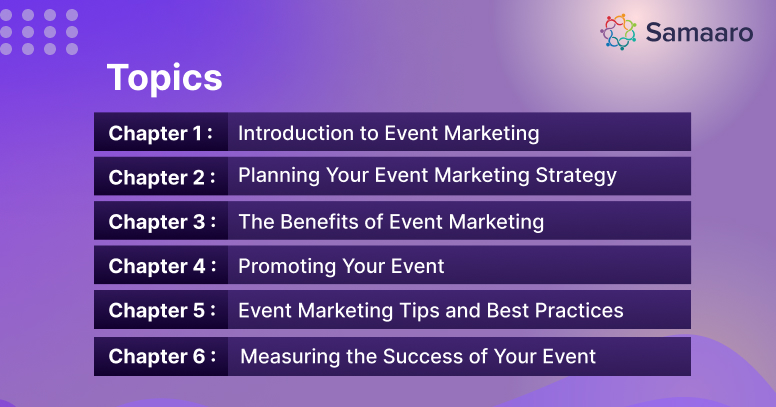
In recent times, the business world has undergone a profound transformation. The emergence of digital marketing may give the impression that conventional approaches to engagement have been sidelined. However, there is a resurgence of interest in current events, and with good reason. People are always curious about authentic, in-person encounters. They desire a personal connection with brands, and events offer the ideal platform to do so.
Event marketing is no longer an option but a necessity in the modern era. By breaking through the digital noise, events enable you to leave an indelible mark on your audience. They provide a platform to exhibit one’s products or services, foster connections, and cultivate a devoted clientele.
This comprehensive guide is designed to be your go-to resource for planning, executing, and measuring the impact of your event marketing efforts as an event organizer. We’ll walk you through the entire process, from understanding what event marketing is, to setting clear goals, promoting your event, ensuring seamless execution, and measuring success.
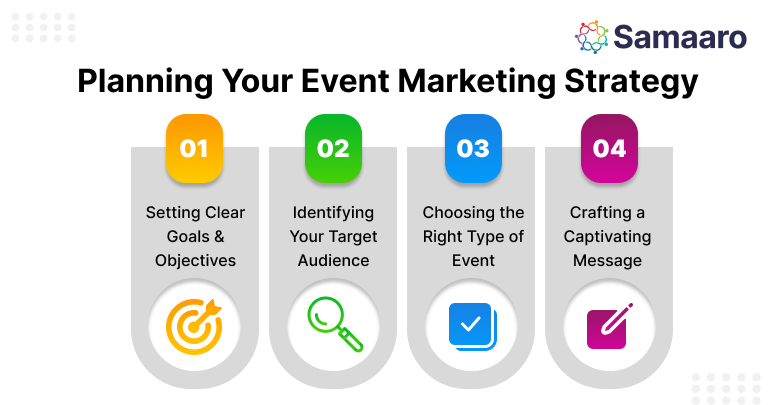
Having a well-thought-out plan in place is crucial before you start preparing an event. This chapter will walk you through the fundamental procedures to make sure your event marketing is purposeful and in line with your company objectives.
Setting Clear Goals and Objectives
As an event organizer, you are aware that the key to any successful event is having a clear goal in mind. We will discuss how to create goals and objectives for your event that are SMART (Specific, Measurable, Achievable, Relevant, and Time-bound). For example, if you’re planning a corporate seminar, your objectives might be to draw in 300 experts from the industry, produce leads, and raise brand awareness in the intended audience.
Identifying Your Target Audience
Understanding your audience is one of the core elements of event marketing. As the event organizer, you need to describe the kind of individual you want to see there. Take into account interests, pain issues, and demography. Make your event fit their interests and requirements. Your marketing strategy will be very different from that of an event targeted at art fans, for instance, if your event is for tech aficionados.
Choosing the Right Type of Event
Every event is not done equally. The kind of event that best fits your objectives and target audience must be carefully chosen by you as the event organizer. Selecting the appropriate format is essential. Some examples of formats are workshops, product launches, conferences, seminars, trade shows, or special hybrid events that incorporate aspects of multiple formats. For instance, a conference might be the best option if you’re targeting professionals looking for educational information. On the other hand, if you want to introduce a new product to prospective buyers, a product launch can be perfect.
Crafting a Captivating Message
The messaging of your event is the central focus of your marketing campaigns. Creating an engaging message that connects with your audience and establishes the tone for your event is your responsibility as an event planner. For example, if you are planning a charity gala, emphasize in your message the importance of participants’ contributions to the community and the cause you are supporting. However, if you’re throwing a music festival, you should emphasize the fun, the lineup, and the entire experience in your messaging.

As an event organizer, you are aware of the many advantages that can result from your efforts in event marketing. Let’s take a closer look at these advantages.
Increasing Credibility and Visibility of Brands
Events present a special chance to raise the profile and trustworthiness of your brand. Events are a great way for you as an event planner to highlight the principles, skills, and character of your company. You may build a reputation for excellence by producing events that are consistently of the highest caliber.
For instance, Apple’s product launch events have grown to be legendary and have greatly enhanced the brand’s image for creativity and cutting-edge technology.
Building Robust Relationships with Customers
Deep relationships are forged through personal interactions. You have the opportunity to build trusting relationships with your clients as an event planner. You may increase consumer loyalty by having in-person interactions and offering good experiences or content.
For example, hosting a user conference for software clients fosters a community where users can interact, exchange stories, and offer candid criticism—all of which help to improve consumers’ perceptions of your company.
Generating Leads and Driving Sales
Events are a powerful technique for generating leads. You can draw in clients who are actually interested in your goods or services as an event planner. Gathering contact details from attendees and interacting with them throughout the event will help you produce leads that are more likely to become sales.
A trade show booth featuring captivating product demonstrations, for instance, can draw in visitors who are inclined to make a purchase down the road.
Building a Community Around Your Brand
As an event organizer, you may lay the groundwork for creating a devoted following of brand evangelists. You may encourage a sense of loyalty and belonging by organizing events that unite people who share similar interests.
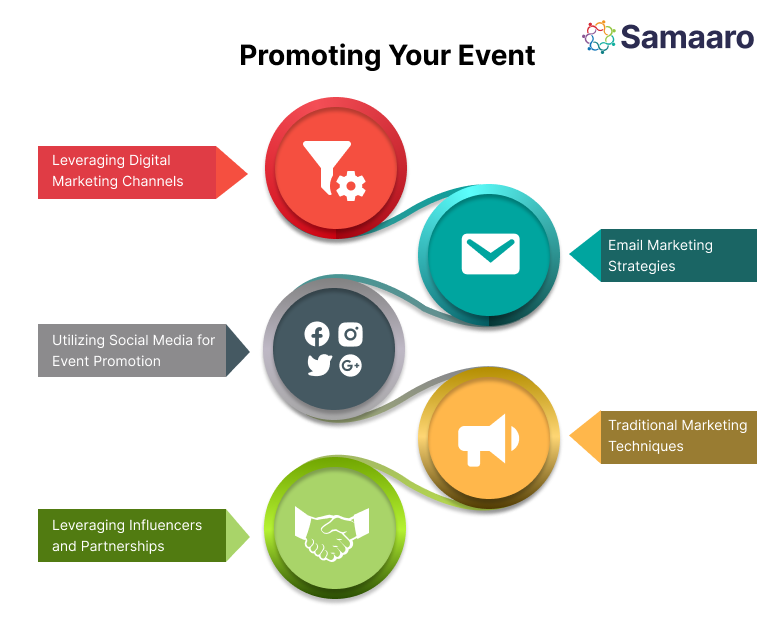
After you have a plan in place, it’s time to effectively market your event. We’ll look at many marketing avenues and strategies in this chapter to make sure the correct people learn about your event.
Leveraging Digital Marketing Channels
When it comes to promoting events, digital marketing is essential. As the person planning the event, you ought to maximize your internet visibility. Make sure your website has all the information people need to know about your event, such as the schedule, speakers, and registration information. Use SEO (Search Engine Optimization) to increase the online visibility of your event. To promote your event on websites like YouTube, think about making interesting videos and using online advertising to attract a wider audience.
Utilizing Social Media for Event Promotion
Social networking sites are becoming priceless tools for promoting events. You can use Facebook, X (Twitter), LinkedIn, Instagram, and other networks to efficiently promote your event as an organizer. Create material that is interesting to share. To foster a feeling of community and inspire participants to share their joy, use hashtags unique to the event. Provide teases, behind-the-scenes photos, and suspenseful narratives.
LinkedIn can be utilized, for instance, to establish connections with tech industry people and disseminate information about your upcoming technology conference. You can use visually appealing images and stories on social media sites like Instagram to highlight the venue, speakers, and general atmosphere of your event.
Email Marketing Strategies
Email marketing is still a very effective way to advertise events. You may reach potential attendees by creating efficient email marketing as an event organizer. To spark attention, begin with customized invites. As the date of the event draws near, send out reminders. Provide all pertinent information in your emails, including links for registration, speaker bios, and the agenda. To incentivize recipients, you can also provide exclusive discounts or incentives for early bird registration.
Traditional Marketing Techniques
Don’t undervalue the effectiveness of conventional marketing techniques, even though digital marketing is crucial. As an event planner, you ought to think about combining offline tactics with your online ones. Creating and distributing printed items like flyers, posters, and brochures may fall under this category. Attendees frequently value reusable, visually appealing marketing materials that they can handle and consult. Furthermore, if traditional media channels still resonate with your target audience, don’t discount them as a means of targeting specific demographics. Examples of these channels are newspapers and radio.
Leveraging Influencers and Partnerships
Working together may change the game when it comes to promoting events. To increase the reach of your event, as an organizer1, think about finding and collaborating with strategic partners and influencers. Working together with influencers in your field can help you reach out to their current fan base, which will increase the visibility of your event and give you credibility. Similarly, collaborating with like-minded companies or groups can lead to joint marketing and resource sharing.
For instance, you may collaborate with nearby eateries, food bloggers, and culinary influencers if you’re planning a food and drink festival. Their participation and endorsements can greatly increase the legitimacy and audience for your event.
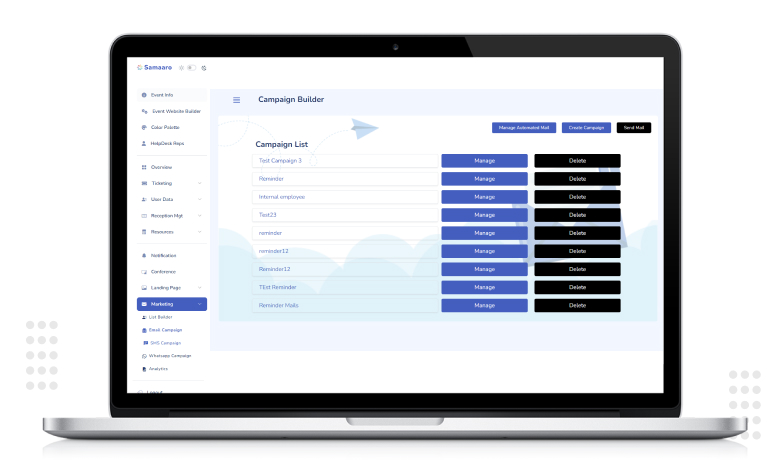
List Building
Collect and store data on all potential and past event attendees in a single location. This includes details like names, contact information, preferences, and attendance history. Successful event marketing hinges on effective audience targeting. In the digital age, having a well-organized list of potential and past attendees is invaluable. An event marketing dashboard simplifies the process of list building by offering a centralized repository for all your audience data.
Audience Segmentation
Once you’ve built your list, the next step is to segment your audience effectively. Audience segmentation involves categorizing your contacts into distinct groups based on specific criteria. This allows you to send personalized and highly relevant messages to different segments of your audience. Segment your audience by engagement levels, distinguishing between highly engaged, moderately engaged, and less engaged individuals. This helps in creating targeted re-engagement campaigns. Different segments of your audience may have varying interests and preferences.
Targeted Marketing Campaigns
Using audience segmentation, you can send content that caters specifically to each segment. For instance, you can send detailed technical content to the segment of your audience interested in technical aspects, while providing high-level overviews to those who prefer a broader perspective. Beyond improving your targeting and engagement, list building and audience segmentation offer a wealth of data-driven insights. By analyzing the performance of each segment, you can refine your marketing strategies, track attendee behavior, and make informed decisions for future events.
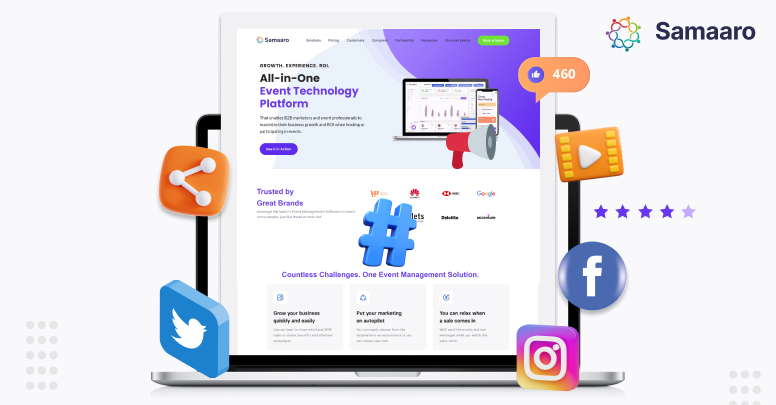
Integration
Thematic Event Website Builder: Samaaro’s thematic event website builder is a powerful tool that allows you to create stunning and highly customizable event websites. It offers features like drag-and-drop design, pre-designed templates, and real-time updates. This enables you to effortlessly craft an engaging online presence for your event, complete with branding and content customization.
Email Campaigns: Samaaro simplifies event promotion with its email campaign capabilities. You can seamlessly create and manage email campaigns, reaching out to your target audience with event updates, reminders, and important information. The platform provides analytics to track the success of your campaigns, ensuring efficient communication.
Push Notifications: Samaaro’s push notification feature is an asset for event organizers. It allows you to send real-time updates, announcements, and reminders directly to attendees’ devices. This instant and direct communication channel enhances attendee engagement and ensures that they stay informed throughout the event.
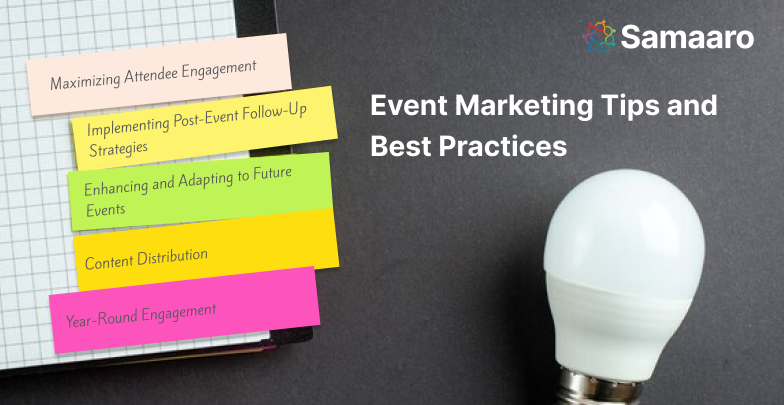
As an event organizer, now that you have mastered the fundamentals, it is time to investigate advanced strategies and best practices that will increase the effectiveness of your event marketing efforts.
Maximizing Attendee Engagement
Attendee engagement is critical to the success of your event as an event organizer. There is a greater likelihood that engaged attendees will retain the information presented at the event and create lasting memories of their experience. To optimize user involvement, take into account the subsequent tactics:
Implementing Post-Event Follow-Up Strategies
When the event concludes, it is not over. Post-event follow-up is of the utmost importance for event organizers to preserve relationships and guarantee a lasting impression. Execute the subsequent strategies:
Enhancing and Adapting to Future Events
It is crucial for event organizers to consistently modify and enhance their event marketing strategies. The following are several critical domains to concentrate on:

The success of your event goes beyond the applause on the day; it’s about achieving your goals and proving a return on investment. As an event organizer, it’s crucial to measure the impact of your efforts.
Defining Key Performance Indicators (KPIs)
The Key Performance Indicators (KPIs) that are most pertinent to your event and business goals should be defined by you as the event organizer. KPIs are measurable indicators that assist you in determining the event’s success. For event marketing, event technology platforms like Samaaro come into the picture that can provide a lot of data and analytics to make the upcoming events better by analyzing this data.
Collecting and Analyzing Data
When evaluating the success of your event, data is an event planner’s best friend. Gather information from a range of sources, including survey questions conducted on-site, registration forms, social media analytics, and ticket sales platforms. Gain useful insights into the behavior, preferences, and demographics of attendees by analyzing this data.
Track attendance, session popularity, and engagement levels with event management software. Track social media data to gauge the online attitude and reach of your event. You can modify your marketing and event plan for upcoming events by examining this data.
The Importance of Attendee Feedback
Attendee input is very valuable. Gathering input from attendees can help you as the event planner identify what went well and what needs to be improved. Give participants a chance to voice their thoughts by using surveys or assessments conducted after the event. Aspects such as the overall experience, event organization, and topic relevancy should be covered in the questions.
Additionally, think about holding interactive exercises that promote real-time feedback or in-event feedback sessions. Feedback from attendees not only demonstrates your appreciation for their opinions but also helps you improve future events.
Monitoring ROI (return on investment)
As an event organizer, return on investment (ROI) is a crucial indicator for evaluating the event’s financial impact. Compute the return on investment (ROI) by contrasting the total revenue of the event—which includes ticket sales and any sales made on-site—with the total expenses—which include personnel costs, venue rental, marketing, and other expenses. A high return on investment (ROI) suggests that your event was profitable.
In the world of event marketing, success is not measured by the number of attendees alone. It’s about creating memorable experiences, fostering meaningful connections, and achieving your strategic goals. As an event organizer, you have the power to leverage event marketing to enhance your brand’s visibility, build a community, and drive success like never before.
Experience Samaaro and unleash the power of automated event marketing, start your free trial today!
Imagine this – a room full of energy, lots of faces slowly moving in as part of the big ceremony. For event organizers, it is iconic. But what if you could also open the data behind all those faces? The answer is with the event check-in data.
Did you know that the event check-in data is the event organizer’s most valuable resource? Not only is it a treasure trove of information that can help turn an average event into a magnificent event, but in a detail-oriented industry using data and data analytics for event check-ins is revolutionary.
Now that we have created the scene of the possibilities, we can now consider data collection and the analytics in event check-ins. The event check-in data is extremely valuable with the primary benefit of delivering individualized experiences for attendees, managing events better and forecasting trends. Let’s begin by unlocking the data opportunities to create value for both event organizers and participants alike.
Traditionally, event check-in was simple for event organizers – check-in simply showed who showed up. Based on that simple definition, you can at least be certain that the right persons showed up at the right place and at the right time. Event check-in has been evolving, and I mean, evolving, into new roles as the technology and audiences evolved.
It is probably undeniable that event check-in data has transitioned from simple headcounts to critical components in extracting insights beyond just attendance. A more individualized and data-driven role is no longer seen merely as an opportunity for enhancement to event planning for facilitators.
Categories of Data Gathered at Event Check-In
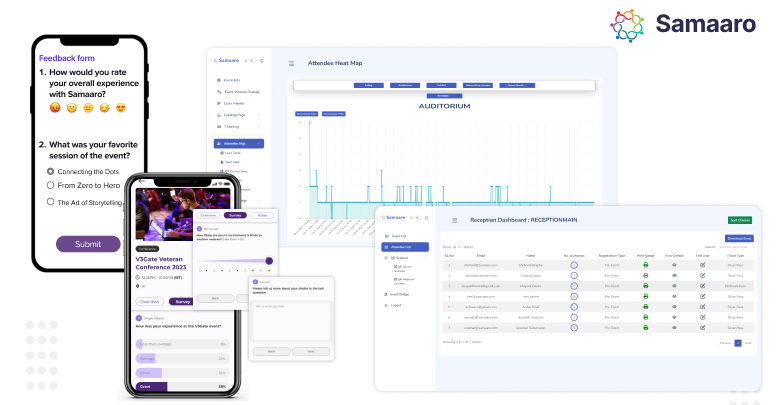
Trends of social interaction and networking geographically:
Enhancing and Streamlining the Logistics of the Event
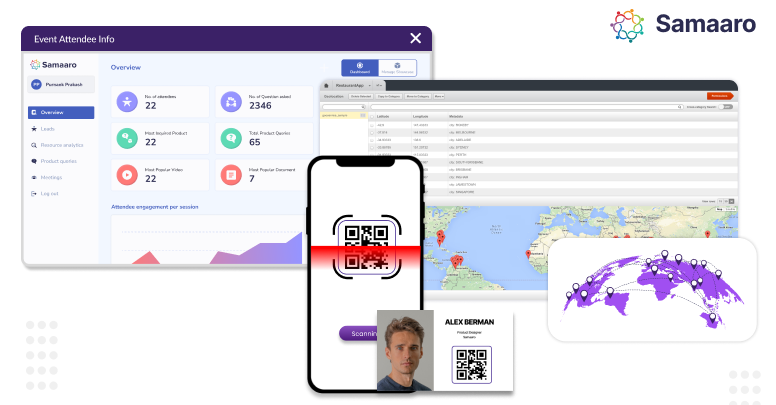
Track Session Attendance- Event organizers should collect data on session attendance from the event, to see which sessions were attended more frequently, and which speakers garnered the most attention, this can be useful when determining your programming for future events.
– Mobile apps- Depending on which event technology platform you decide to use- like Samaaro, you may be able to access mobile apps for attendees. Mobile apps can also allow for event planners to collect data about the sessions attended by attendees and/or the extent to which attendees interacted, as well as live feedback, which can help to guide your reflection and analysis of the event for the purpose of uncovering trends about your attendees.
– Real-Time Analytics- Utilize a dashboard within your event technology platform that has real-time analytics so that you can track any number of activities, including monitoring the activities of attendees during the event, involve ticket sales, and so much more.
– Integrating with CRM and Marketing/ Engagement Tools- Many event tech platforms will allow you to integrate your CRM and marketing tools. Use the opportunity to gather and analyse your data from various systems so you can have an overarching view of your attendees.
– Monitor Social Media Product- Many event technology platforms have social integrations. Follow along through event hashtags and mentions to gain a sense of your social activity. This will allow you to make sense of sentiment and engagement from attendees.
– Data Security and Compliance- Data privacy law is something that cannot be taken lightly; data security and generally the importance of data protection laws continue to be prominent considerations for many event attendees. Ensure your event follows a standard protocol and procedures and verify that your other suppliers with work alongside the standard for data protection and that you have your event attendee consent to collecting and using the data from event attendees.
– Use Surveys and Feedback Forms- You can give your attendees a voice by utilizing the built in survey option from your event technology platform. Use your survey option both at the event, and after the event to collect to ask for opinions on their event experience, expectations, overall satisfaction with the event, and suggestions for future improvements.
This exploration has illustrated how check-in data is more than “data” and numbers, it identifies that events can be deliberately crafted to deliver an experience- experiences that are memorable and personalized. The events can be communicated in a manner that was efficient so that attendees are left with wanting more. Organizers of events in the modern data era, who understand how they can utilize check-in data to their advantage can realize competitive advantages to shorten the gap between expected and the limitless possibilities that can exceed attendees’ expectations.
Are you ready to elevate your events with Samaaro’s Event technology? Get started with a free trial now!
With the event landscape rapidly changing, the process of measuring Event ROI has become a transformational process that will ultimately shape the future of event planning and marketing. From a data-driven investment climate, measuring success has never been more critical. This preface will not only introduce the changing landscape of the event industry, but also demonstrate, and enumerate, the implications of measuring ROI.
In recent years, the event industry has undergone a broad transformation. Events have transitioned from, temporally, stand-alone events, to a strategic marketing channel, fostering engagement, building brand loyalty, and cultivating revenue. As is often the case with transformation, there has been a shift in expectations, competition, and the pressure of quantifying the impact of every event.
In this article, we will discuss concrete strategies, and metrics, that you can use in the ever-changing landscape of events, so you can strategically plan and execute your events systematically and effectively as possible, to generate a solid return on your event investment. Let us now explore the process of ROI measurement in the event lifecycle and share the tools and methods that today’s event professionals are using to maximize results.
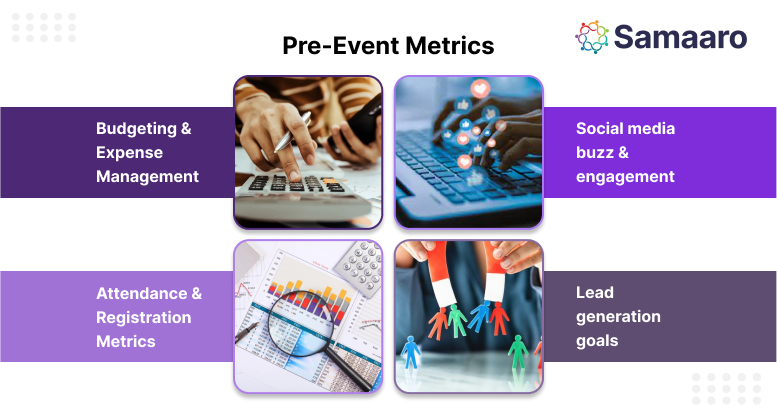
Before you set foot into the venue to start your event, there are several important indicators you can measure to prepare yourself for a successful ROI measurement.
Budget and Expenditure
Budgeting is typically the first stage in event planning. Budgeting, tracking and managing the budget will help inform the ROI. Start with your budget, categorize it, and record all your event’s expenditures to be as strict as you can with your expenses. This helps with discipline and provides a more efficient way of allocating resources. Attendance and registration indicators
The analytics behind the number of registrations and intended attendance are key pre-event indicators. This baseline data can help you understand whether your marketing efforts were successful. How does the number of registrations compare to your targets? Are there adjustments to the marketing approach you will take?
Social media engagement and buzz
In the world of social media, it is hard to dispute its effectiveness in sparking conversations and interest around your event. Several social media metrics need monitored including likes, shares, comments, post impressions, and new followers. All of them can help gauge the excitement and frenzy you are generating around your event.
Lead generation targets
It is no wonder that lead generation is usually the event’s key driver. Create quantifiable objectives around lead generation and have the metrics available to qualify it. While we are not interested in the numbers of already created prospects in advance of the event, these numbers can still provide an understanding of the potential influence the event can have on the sales funnel.
As the event is now in motion utilize metrics indicating real-time experience, and participation.
Attendee Participation
During the event, it is also important to track engagement of attendees. This might include looking at session attendance, workshop or interactive activity participation, and networking. You can track with various mechanisms to evaluate what your event generated with interest and participation.
Audience feedback and surveys
The audience feedback and opinion from event attendees also provide another opportunity for valuable insight. Real-time surveys can help you discover opportunities for improvement and take immediate action to enhance the experience at your event.
Real Time Social Media Monitoring
Monitoring social media during the event is important to understand real-time reactions, sentiment and the overall impact of the event. Tackling issues and trends as they occur can help you manage negative publicity as well as reinforce positive experiences.
Technology and Tools for Data Collection
When an event is underway, modern event management technology will help you collect data in a timely fashion. Using event management tools like Samaaro will add incredible value to your ability to collect and analyze data as it is created.
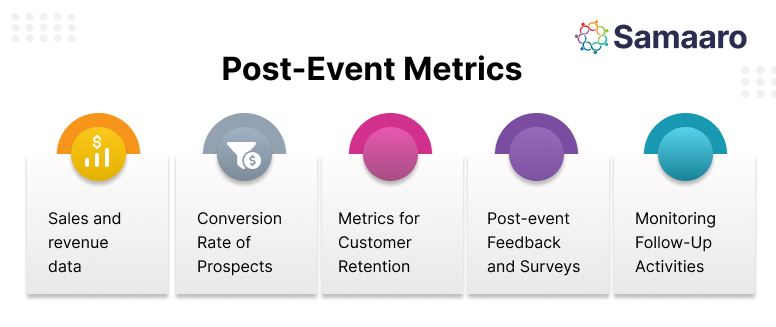
Looking at metrics from the post-event phase will give you a better insight into the impact of the event, and how to evaluate the ROI of the event.
Sales and Revenue Data
Looking at revenue and sales data will help you understand the financial viability of the event. This can include ticket sales, merchandise sales, and dollars spent after the event.
Conversion Rate of Prospects
The conversion rate of leads is the percentage of leads from your event that converted into customers. This is an important metric for any event, but it is especially important if one of your main goals was to generate leads. To calculate the conversion rate, divide the number of converted leads by the total number of leads.
Metrics for Customer Retention
Successful events not only deliver new customers, but they also provide memorable experiences for existing customers. Once the event has ended, you should continue measuring customer retention successfully – by tracking repeat attendance and noticing increased engagement with your brand or your product.
Post-event feedback & surveys
Post-attendance feedback and surveys are a serious need when it comes to gathering valuable insight about an attendee’s overall satisfaction and any areas which could be revisited for improvement.
Monitoring follow-up
Often success with an event hinge on what happens after the event. Follow up events (meetings for examples sales meetings, demos, etc.) will need to be monitored to assess the success of the follow-up process and subsequent lead development campaign.
Samaaro is a powerful event management platform that has many resources to assist with the calculation of Event ROI and the management of the entire event. It offers a way to collect, analyse and report data and integrates your CRM and marketing tech stack and analytics to simplify data retrieval and reporting, which in the end, provides event hosts a broader scope of knowledge and potentially optimal recommendations for future events.
Samaaro’s lead tracking tool allows you to register and manage leads, from the initial point of contact to the ultimate post-event follow-up point. This creates a complete picture of your attendee’s journey and makes it easier for your sales team to prioritize the leads that have the greatest potential.
In addition, Samaaro’s marketing tools assist with engaging attendees and potential leads prior to your event, during the event, and for a follow-up after the event. Tools for automated email campaigns, social media, and personalized emails can help increase the efficiency and engagement of your event.
Samaaro’s analytical tools should be a key component for every event organizer. With the ability to report on real-time data reporting and visualization, they can keep on top of the progress of their event and decide in the moment what was working and what was not (session by session, activity by activity, marketing strategy by marketing strategy). With the use of real-time data, the event organizer can make findings and changes in moments that could otherwise take months to evaluate and revisit for the credence of it’s customer base.
Event organizers and marketers must report on Event ROI. By focusing on the pre-event, during-event and post-event metrics, as well as using event technology such as Samaaro, it is possible to maximize their event ROI, their event success, improve their strategy and create a greater conversation with impact on their organizational bottom line.

Built for modern marketing teams, Samaaro’s AI-powered event-tech platform helps you run events more efficiently, reduce manual work, engage attendees, capture qualified leads and gain real-time visibility into your events’ performance.
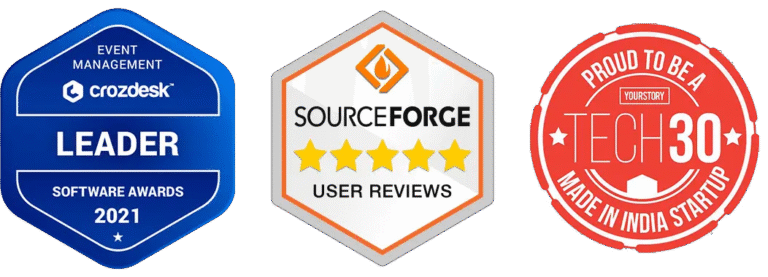
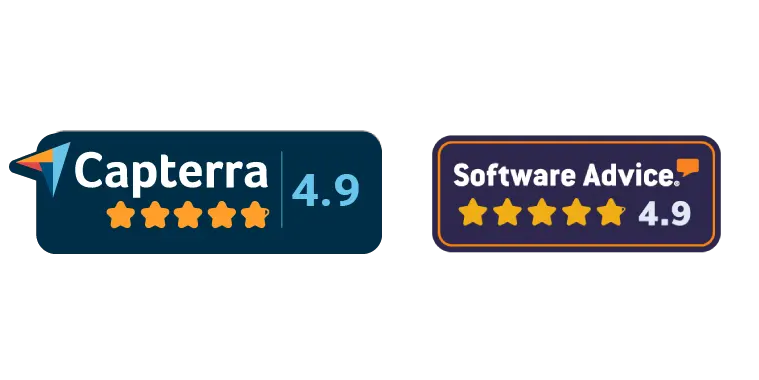
© 2025 — Samaaro. All Rights Reserved.